| ID |
Date |
Author |
Subject |
|
281
|
Fri Feb 25 09:58:08 2022 |
GHC, CB, ML, EM | Current status |
10:58
Started new run: 77
Nozzle clogged more when trying warming again.
Warming up, venting top and bottom to clean nozzle.
|
|
280
|
Fri Feb 25 08:14:47 2022 |
George, Esther | Current status |
9:14
Beam intensity around ~7.5e7
Pressures OK
System check OK
White rabbit fail diff: 24
Write speed: ~1.8Mb/s
Leakage current 3.49uA
Cryostat Setpoint: 121.5K |
|
279
|
Fri Feb 25 06:57:09 2022 |
George, Esther | Current status |
08:00
Beam seems to be back
Intensity ~7.8e7
Pressures OK
System check OK
White rabbit fail diff: 24
Write speed: ~1.3Mb/s
Leakage current 3.49uA
Cryostat Setpoint: 121.5K |
| Attachment 1: 2022-02-25_08-03-21leakage.png
|

|
|
278
|
Fri Feb 25 06:28:12 2022 |
George, Esther | Current Status |
07:30
Some signals on the beam monitor, seems they are optimising it.
System Check OK
Temps OK
White Rabbit fail diff: 24
Leakage Current: 3.48uA
Pressures OK
Data rate ~1Mb/s |
| Attachment 1: 2022-02-25_07-33-44exRate.png
|

|
| Attachment 2: 2022-02-25_07-35-11xyTotal.png
|

|
|
277
|
Fri Feb 25 05:04:16 2022 |
Rui-Jiu Chen, Alex | check |
Still no beam in CRING.
Motor fully out position.
SW3
- Merger OK
- Screenshot uploaded
- Data rate : 217 kbytes/s
SW4
- current plot uploaded
SW2
- T OK
- system wide checks OK
- Check statistics tab ok
- Spectra ok
SW5
4 plots uploaded |
| Attachment 1: Screenshot_from_2022-02-25_06-05-12.png
|

|
| Attachment 2: Screenshot_from_2022-02-25_06-05-32.png
|

|
| Attachment 3: Screenshot_from_2022-02-25_06-06-12.png
|
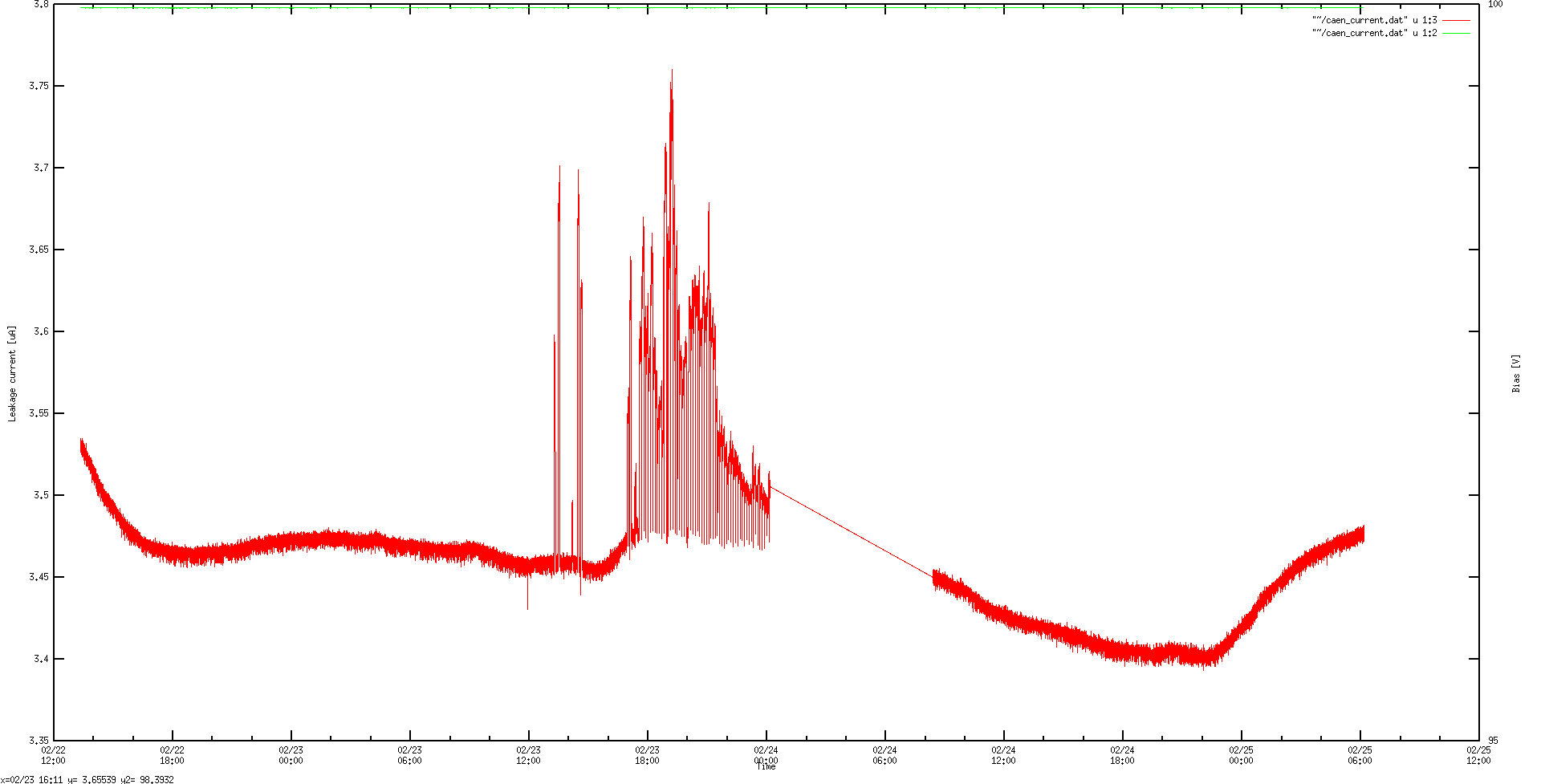
|
| Attachment 4: Screenshot_from_2022-02-25_06-06-49.png
|
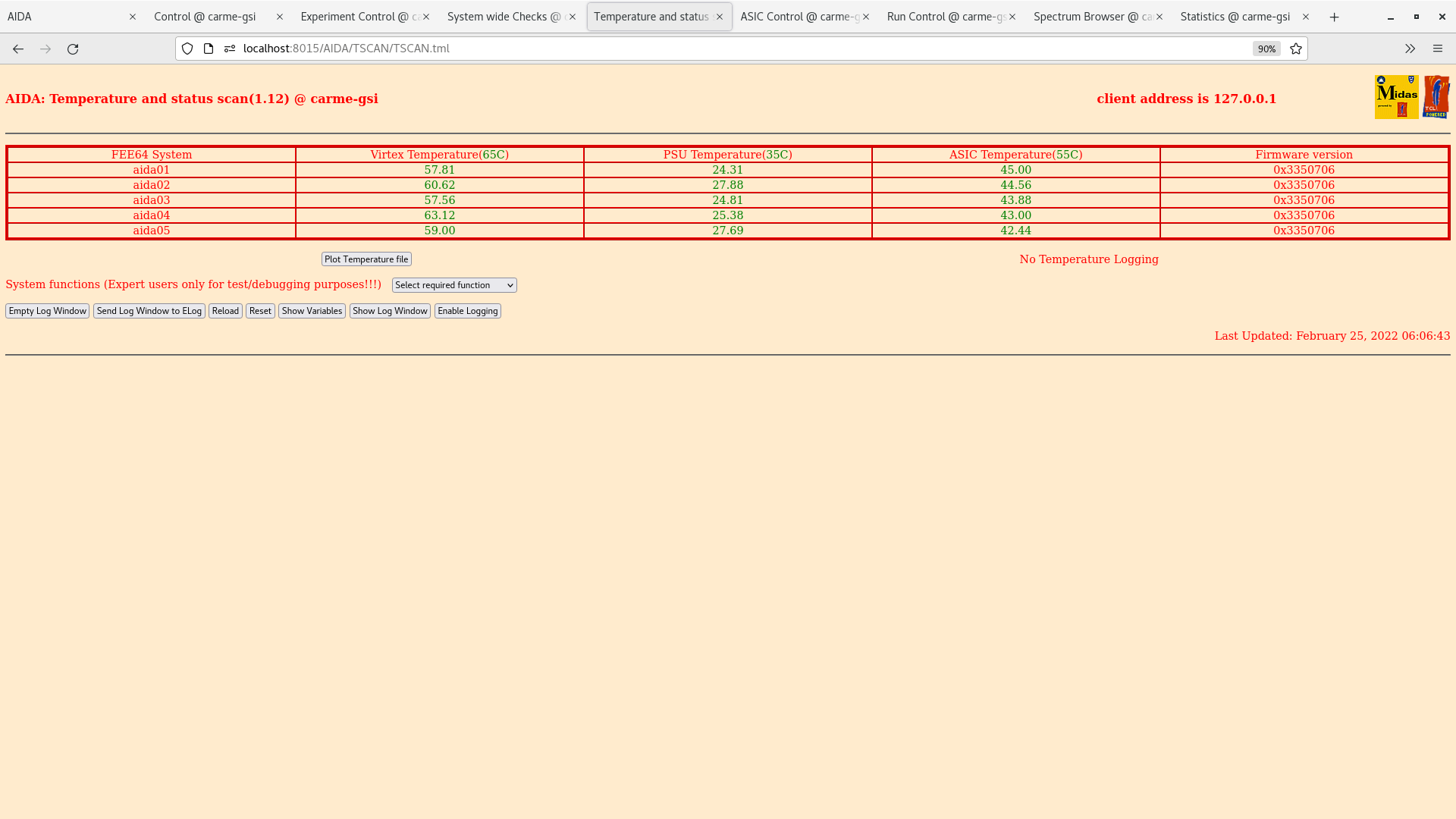
|
| Attachment 5: Screenshot_from_2022-02-25_06-07-24.png
|

|
| Attachment 6: Screenshot_from_2022-02-25_06-07-52.png
|

|
| Attachment 7: Screenshot_from_2022-02-25_06-08-15.png
|
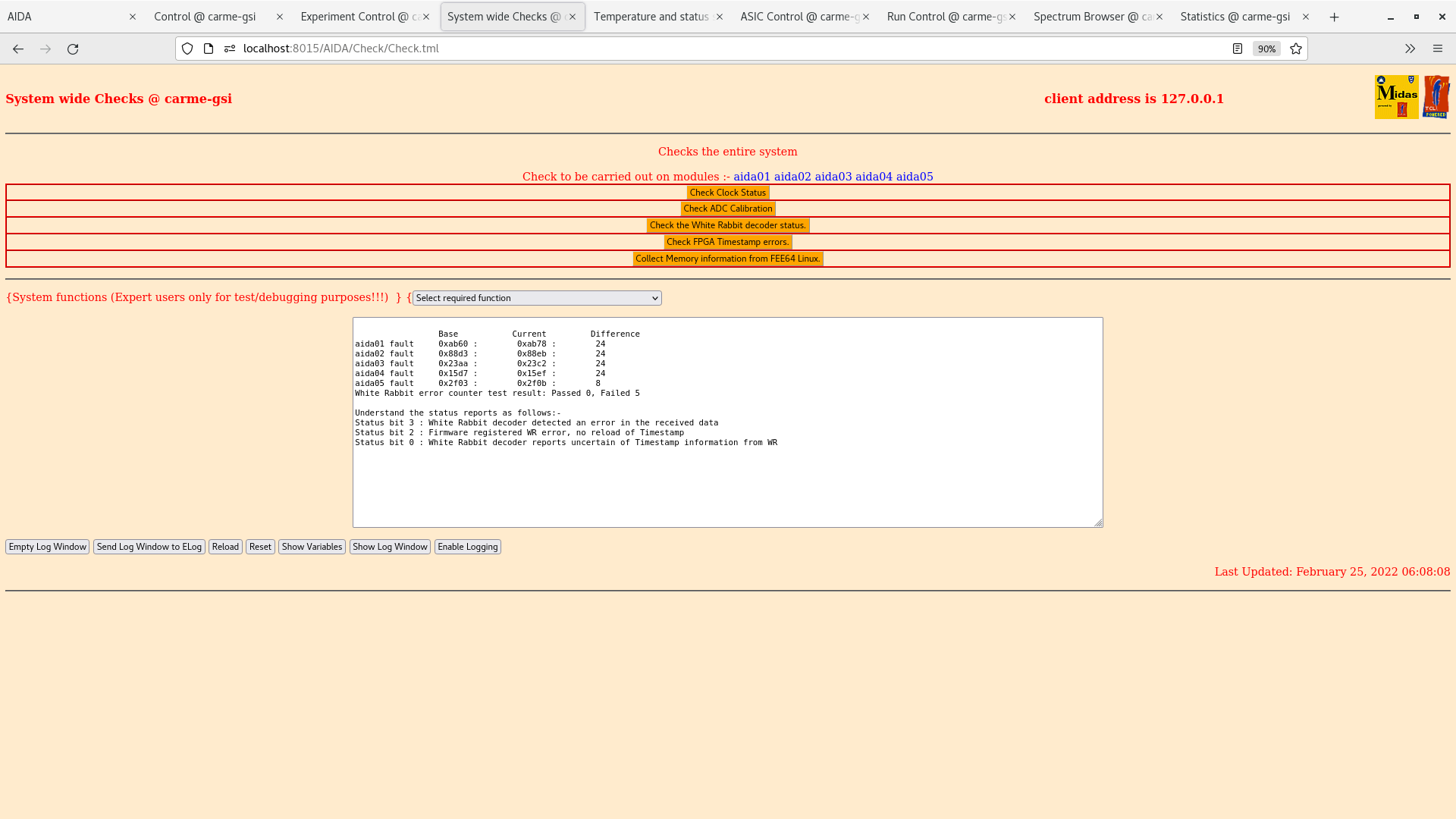
|
| Attachment 8: Screenshot_from_2022-02-25_06-09-09.png
|

|
| Attachment 9: Screenshot_from_2022-02-25_06-09-50.png
|
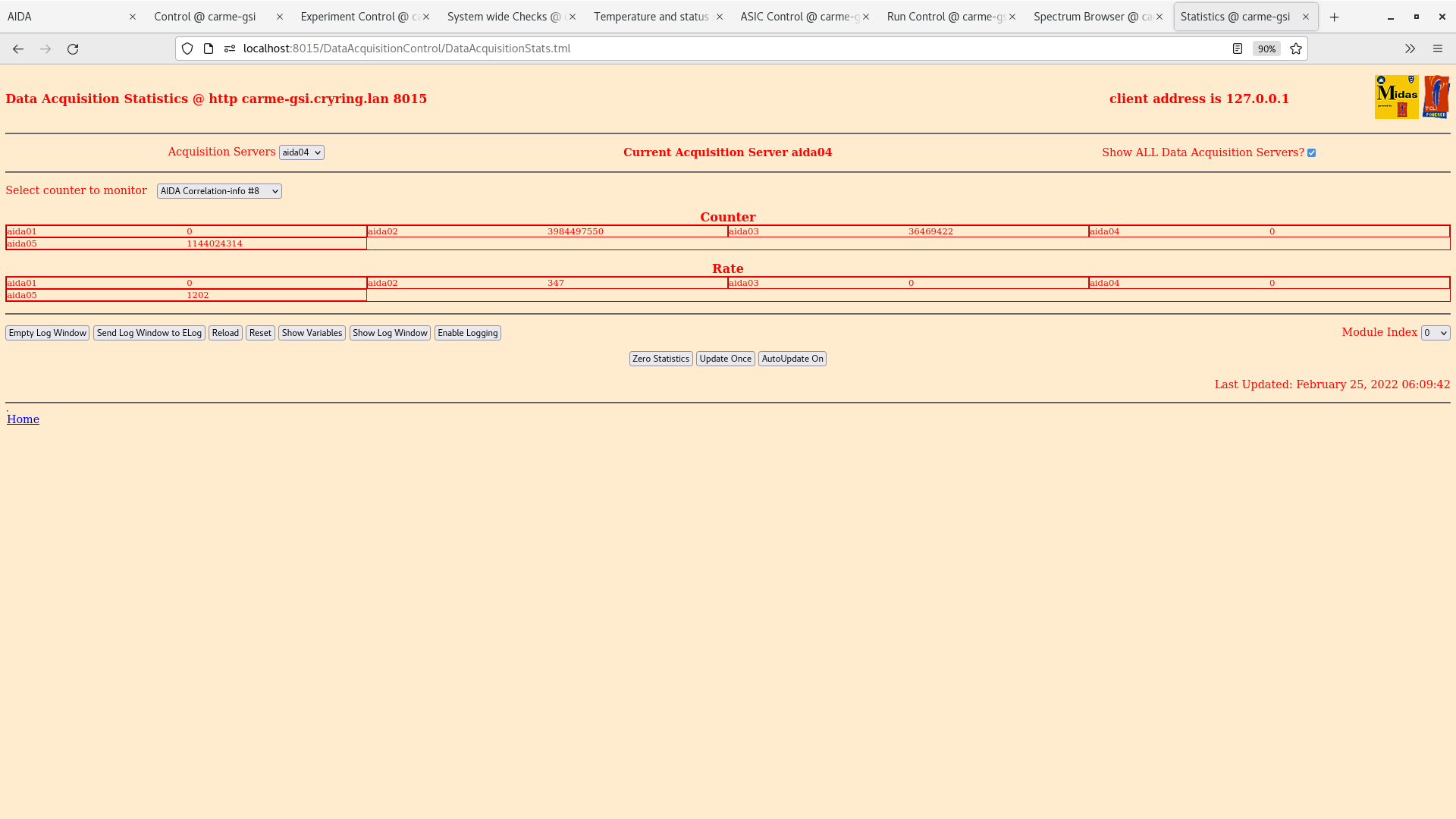
|
| Attachment 10: Screenshot_from_2022-02-25_06-10-35.png
|
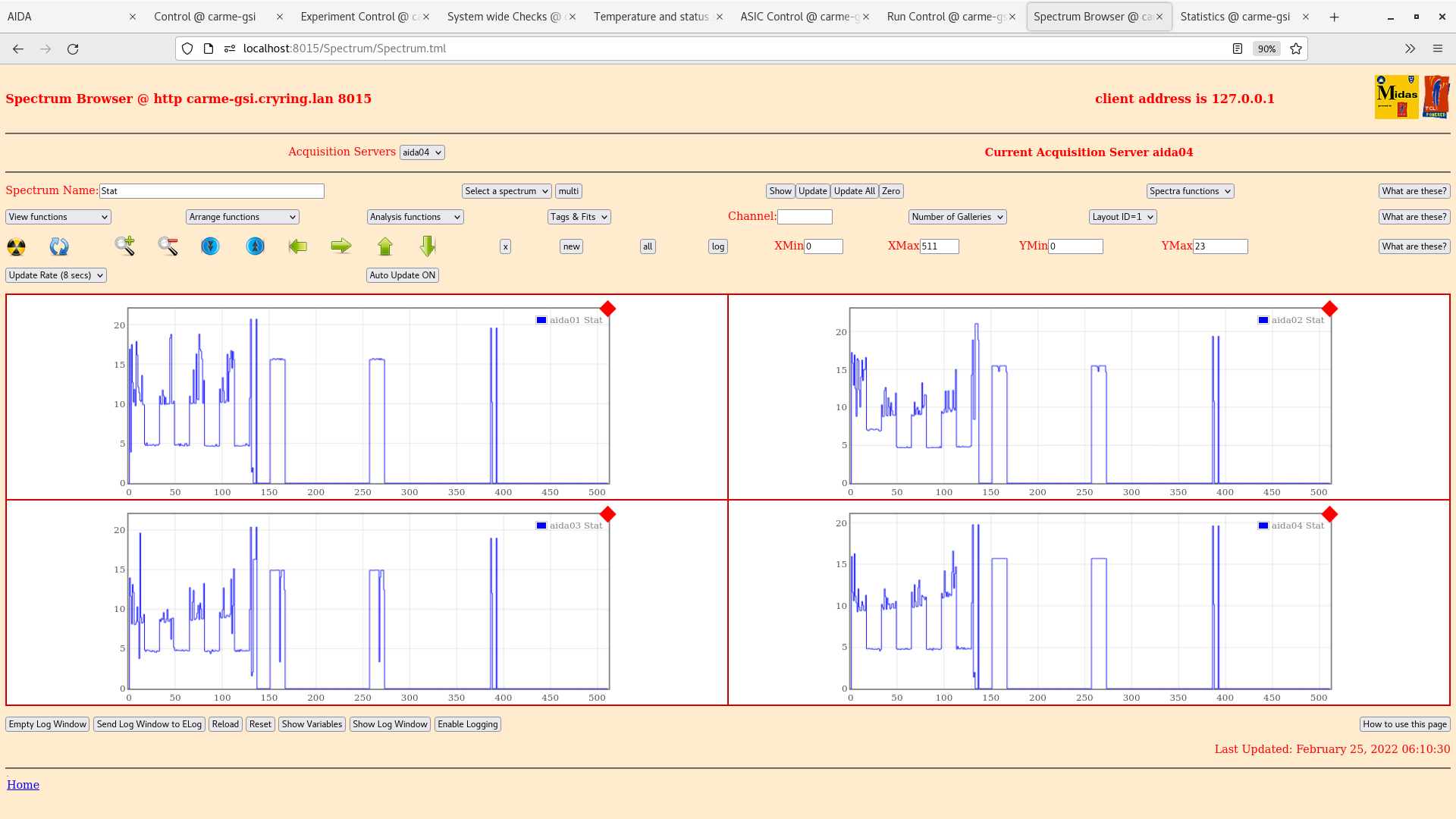
|
| Attachment 11: Screenshot_from_2022-02-25_06-11-27.png
|

|
| Attachment 12: Screenshot_from_2022-02-25_06-12-09.png
|
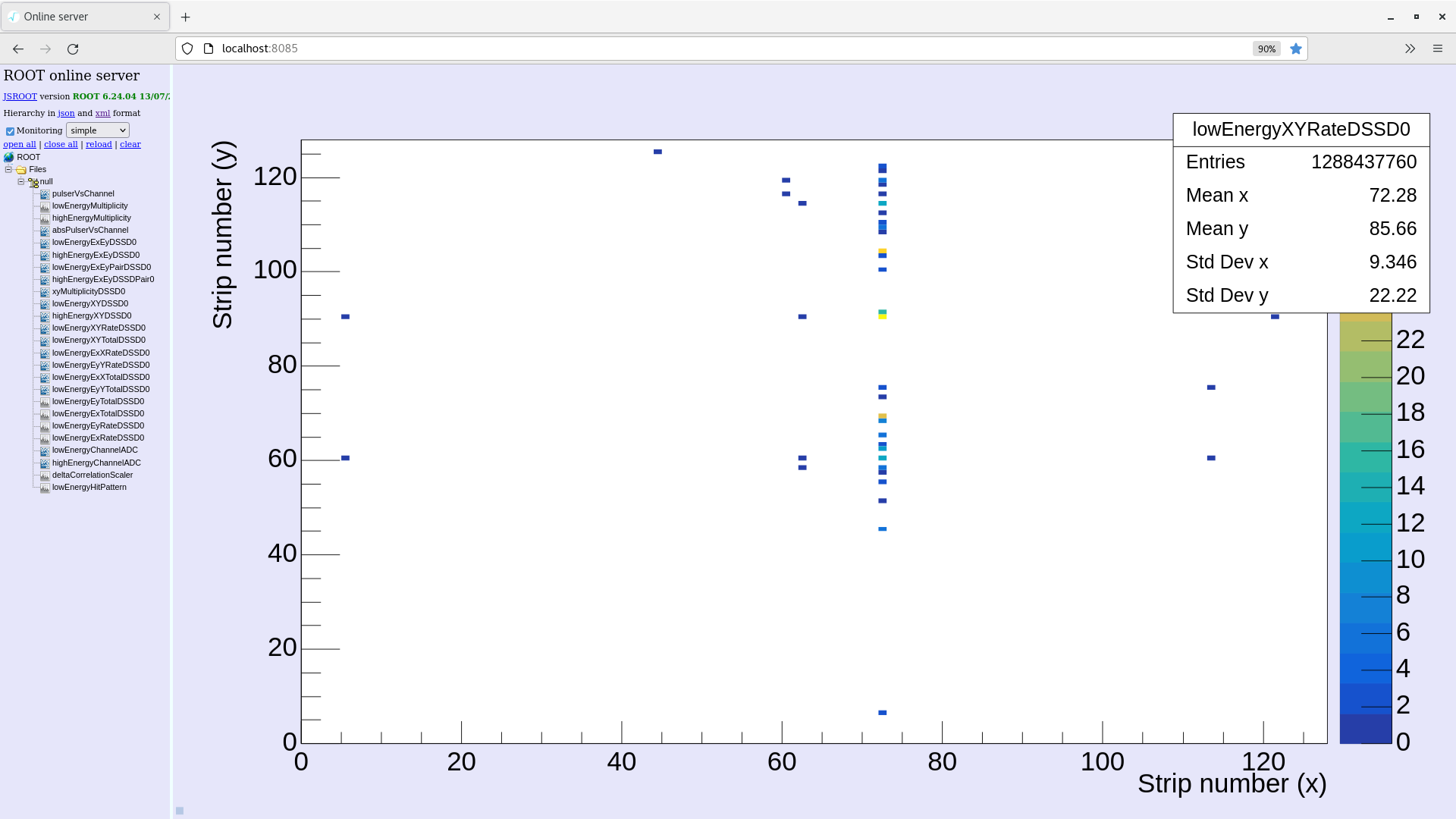
|
| Attachment 13: Screenshot_from_2022-02-25_06-12-41.png
|

|
| Attachment 14: Screenshot_from_2022-02-25_06-13-23.png
|
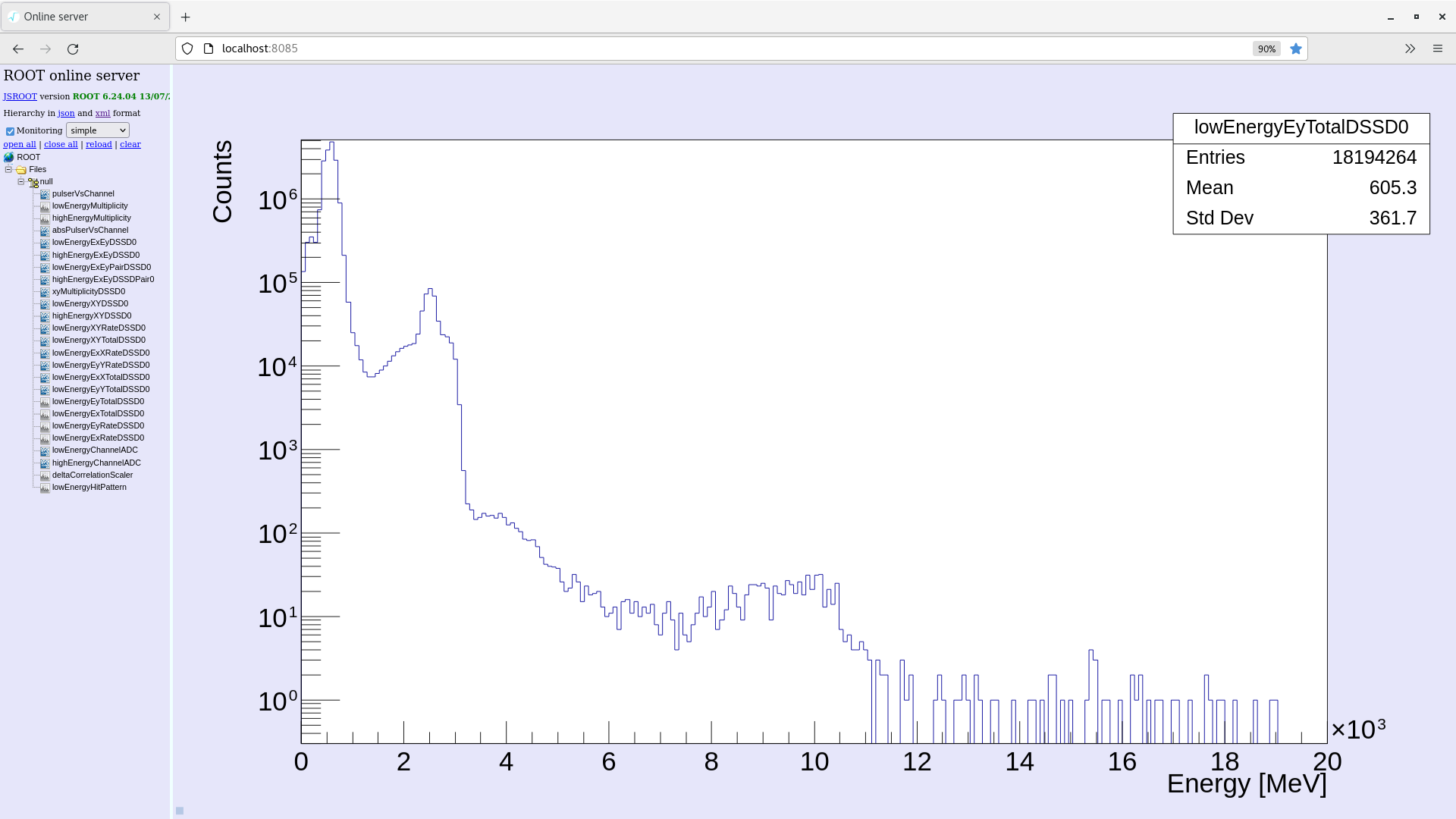
|
|
276
|
Fri Feb 25 03:20:29 2022 |
Rui-Jiu Chen, Alex | Current status |
Gleb Vorobyev tried for few hours to fix the ion source but without success.
So, there will be no beam in CRYRING during this night shift. Today at about 08:00 the efforts to fix the ion source will be restarted. |
|
275
|
Fri Feb 25 03:01:11 2022 |
Rui-Jiu Chen, Alex | check |
Still no beam in CRING.
Motor fully out position.
SW3
- Merger OK
- Screenshot uploaded
- Data rate : 236 kbytes/s
SW4
- current plot uploaded
SW2
- T OK
- system wide checks OK
- Check statistics tab ok
- Spectra ok
SW5
4 plots uploaded |
| Attachment 1: Screenshot_from_2022-02-25_04-02-04.png
|

|
| Attachment 2: Screenshot_from_2022-02-25_04-02-17.png
|
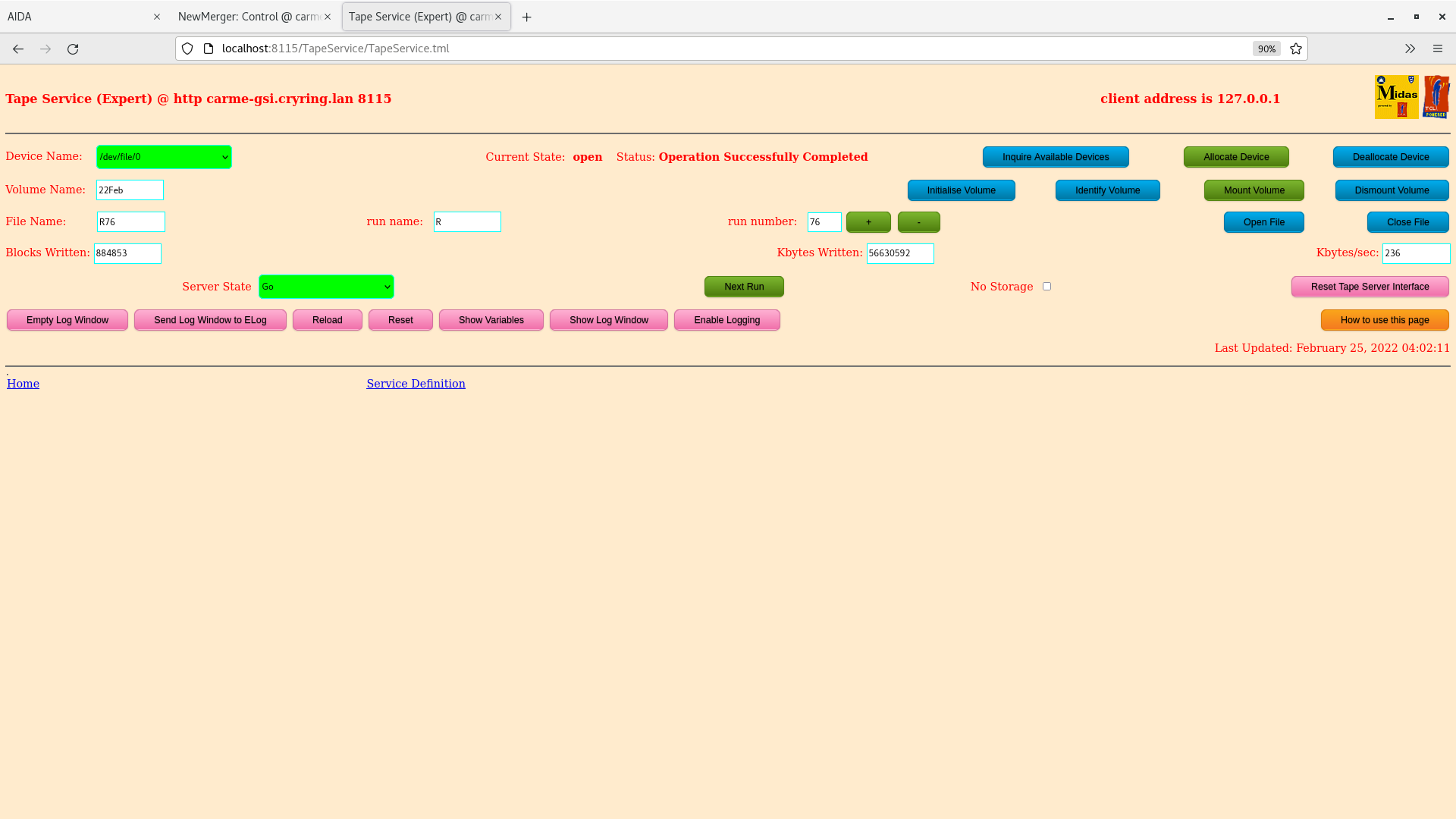
|
| Attachment 3: Screenshot_from_2022-02-25_04-03-14.png
|

|
| Attachment 4: Screenshot_from_2022-02-25_04-03-52.png
|
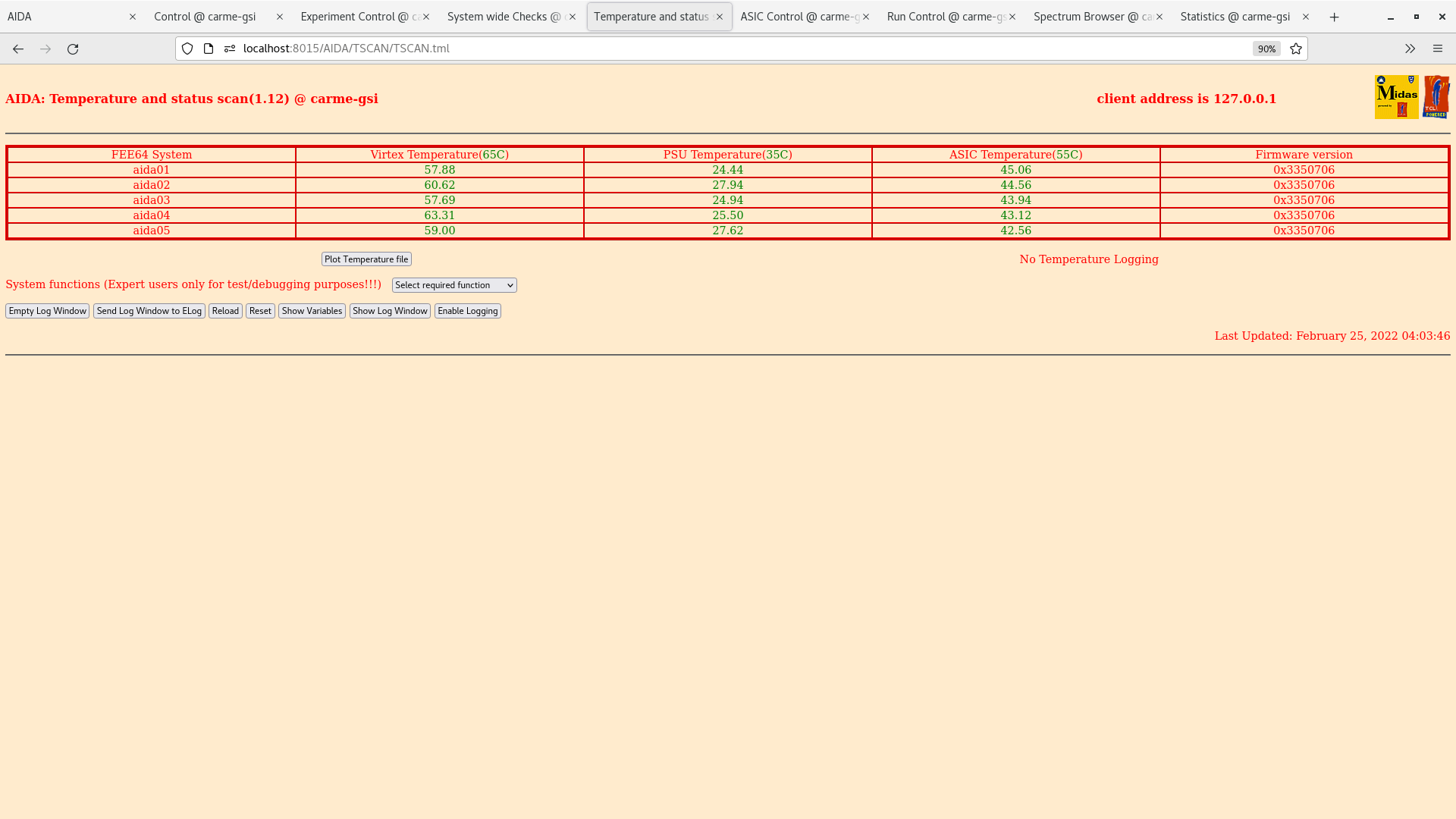
|
| Attachment 5: Screenshot_from_2022-02-25_04-04-21.png
|
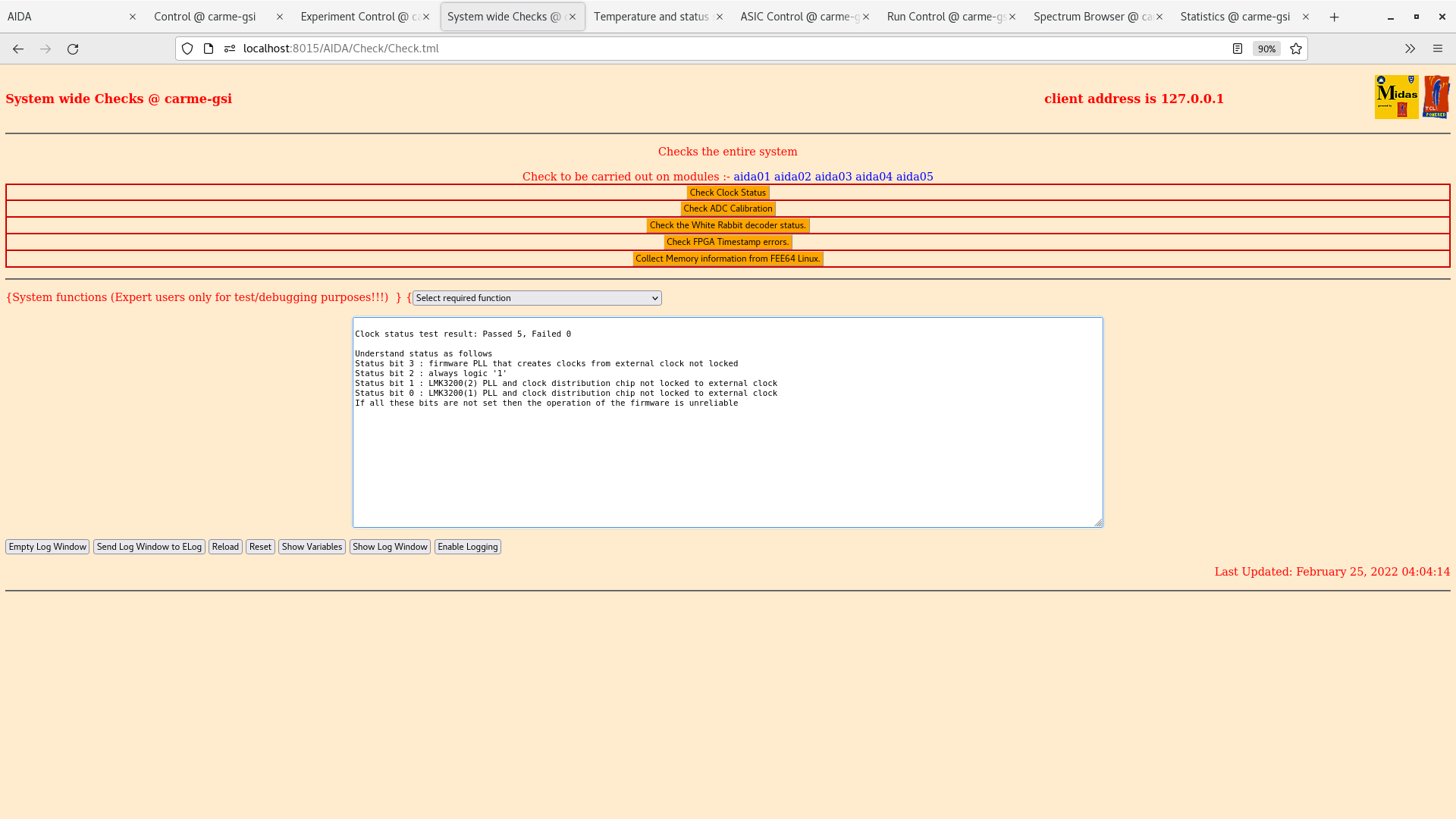
|
| Attachment 6: Screenshot_from_2022-02-25_04-05-04.png
|
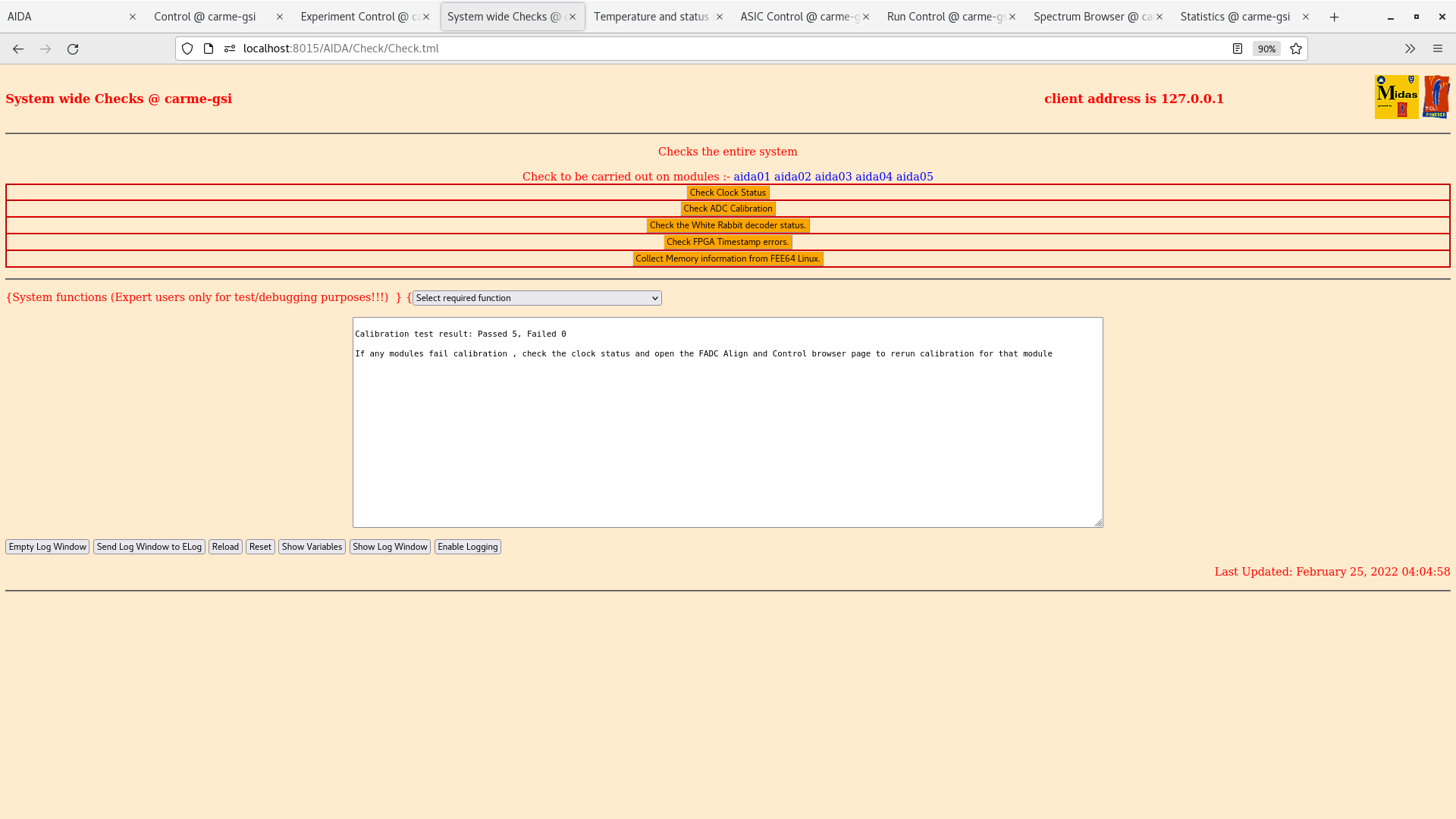
|
| Attachment 7: Screenshot_from_2022-02-25_04-05-35.png
|
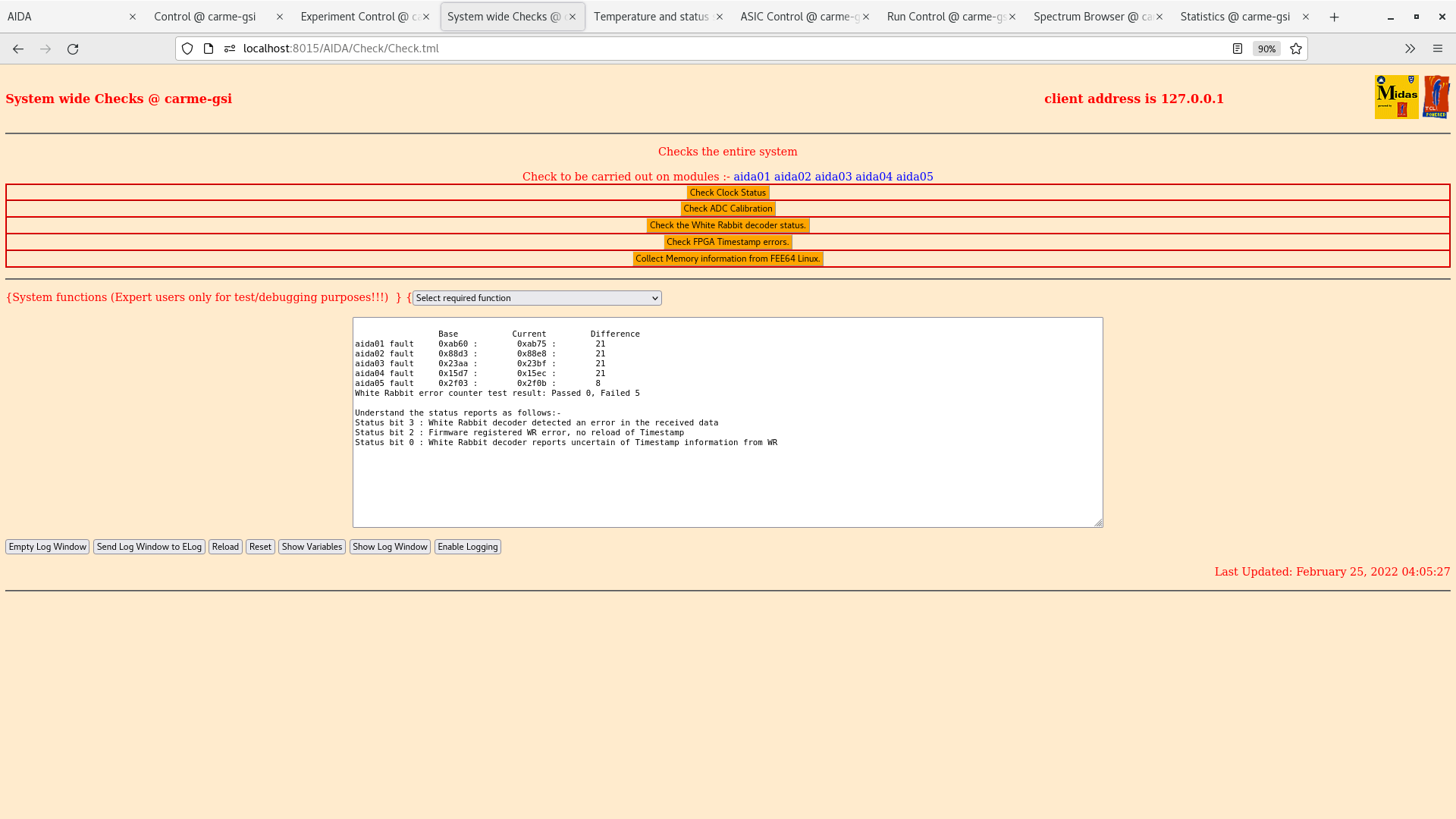
|
| Attachment 8: Screenshot_from_2022-02-25_04-06-25.png
|
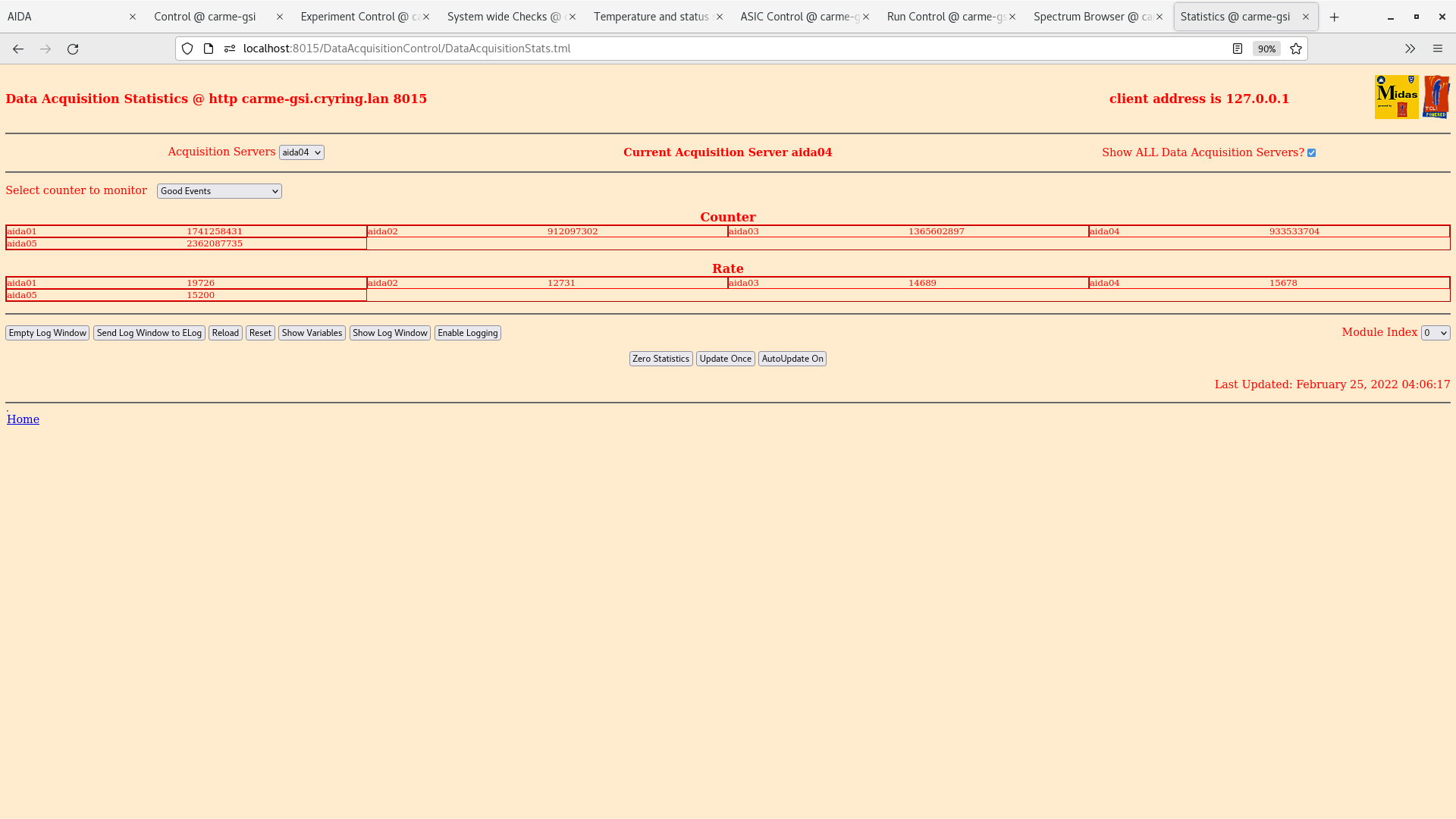
|
| Attachment 9: Screenshot_from_2022-02-25_04-07-06.png
|

|
| Attachment 10: Screenshot_from_2022-02-25_04-07-48.png
|
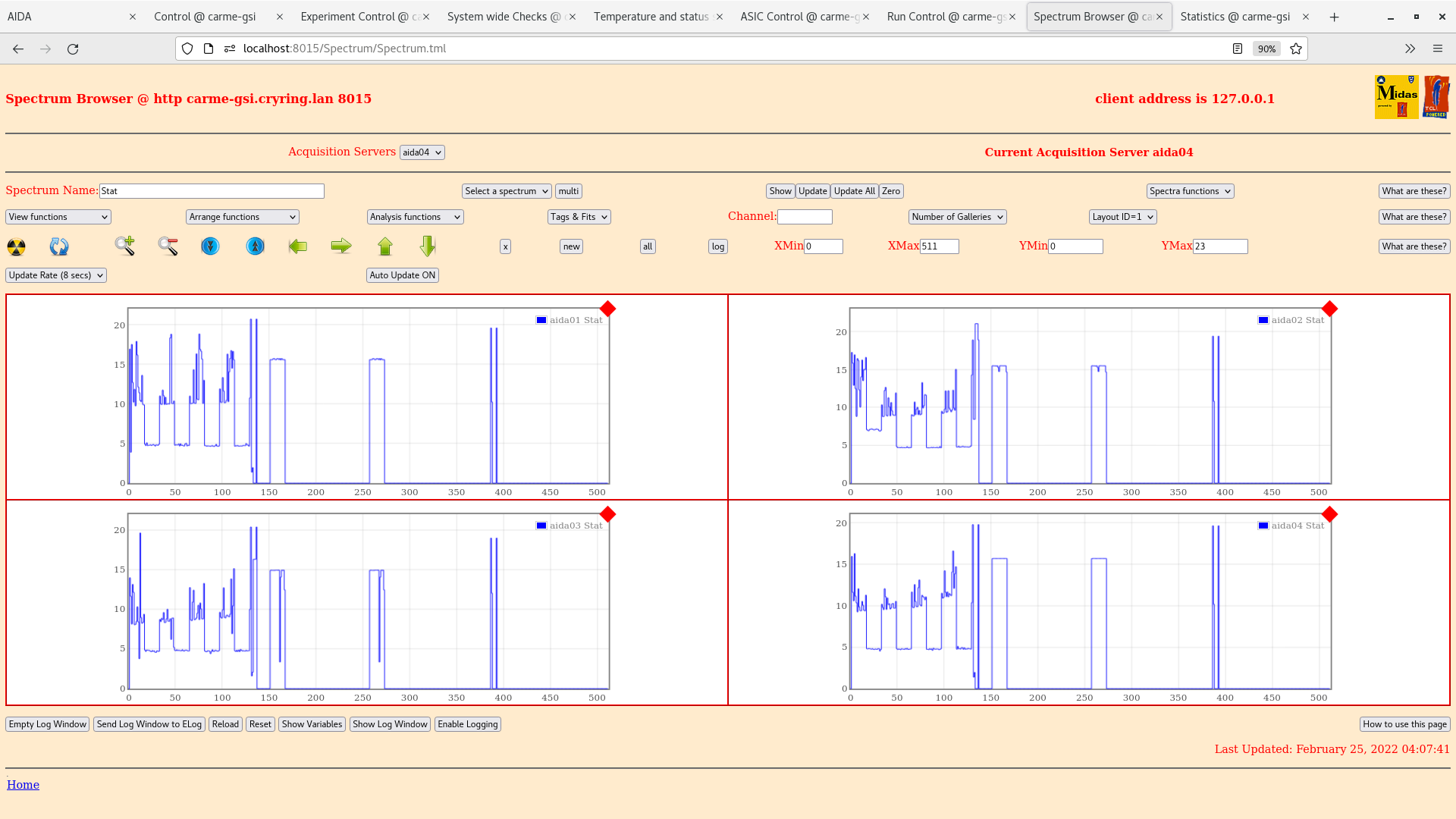
|
| Attachment 11: Screenshot_from_2022-02-25_04-10-05.png
|
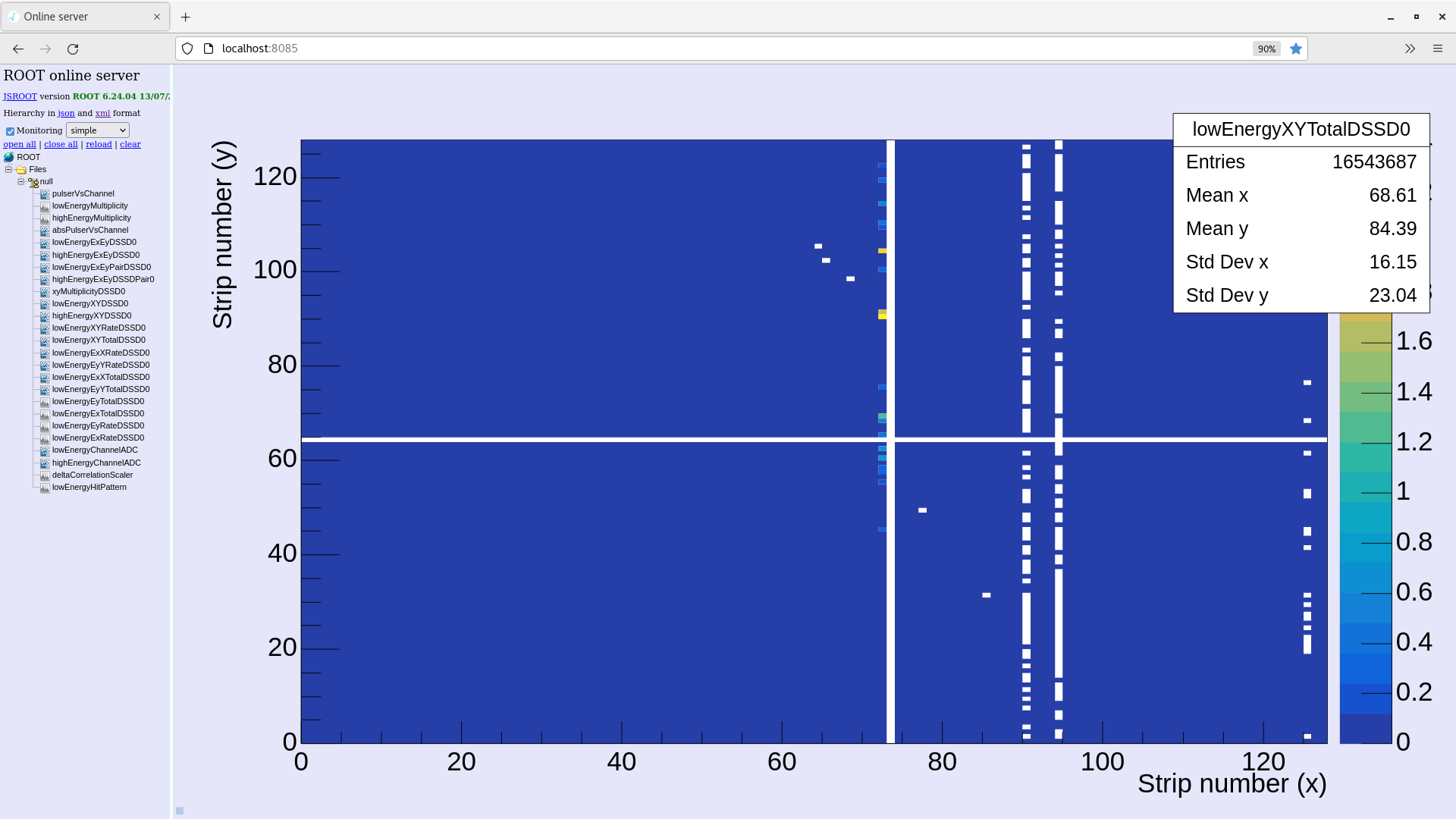
|
| Attachment 12: Screenshot_from_2022-02-25_04-11-13.png
|

|
| Attachment 13: Screenshot_from_2022-02-25_04-12-21.png
|

|
| Attachment 14: Screenshot_from_2022-02-25_04-13-16.png
|

|
|
274
|
Fri Feb 25 01:12:49 2022 |
Rui-Jiu Chen, Alex | Check |
Still no beam in CRING.
Motor fully out position.
SW3
- Merger OK
- Screenshot uploaded
- Data rate : 243 kbytes/s
SW4
- current plot uploaded
SW2
- T OK
- system wide checks OK
- Check statistics tab ok
- Spectra ok
SW5
4 plots uploaded |
| Attachment 1: Screenshot_from_2022-02-25_02-13-46.png
|
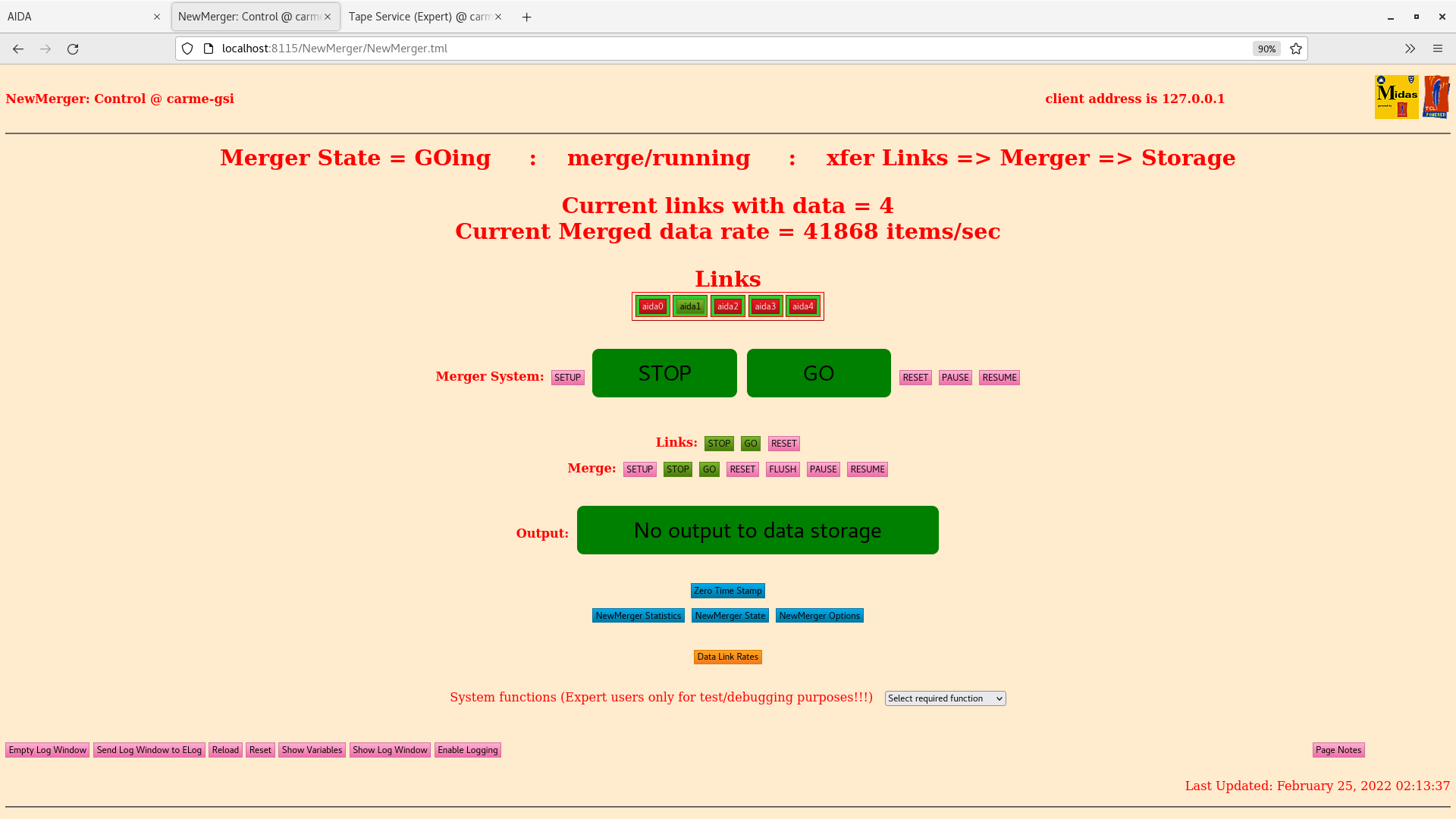
|
| Attachment 2: Screenshot_from_2022-02-25_02-14-56.png
|
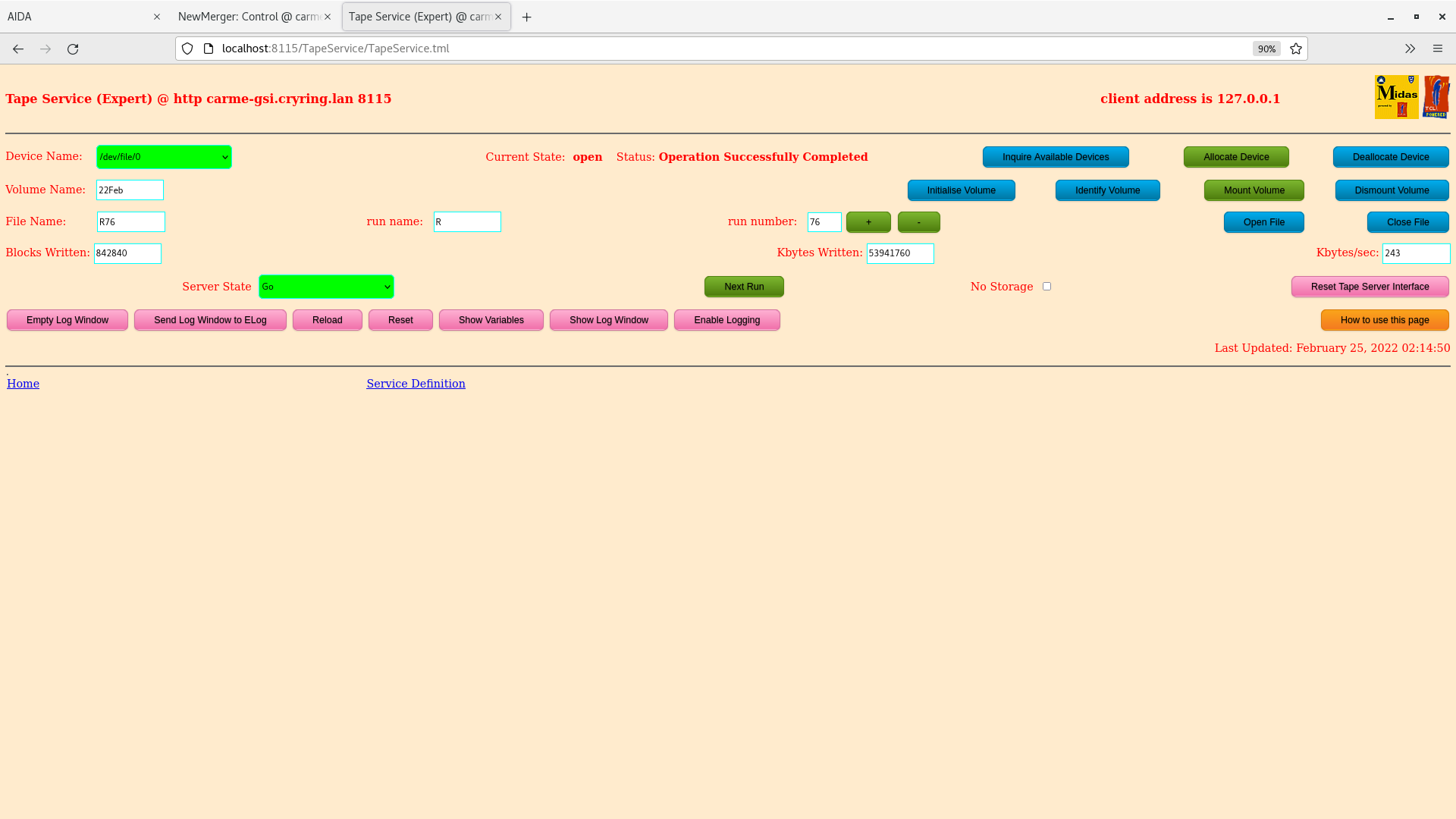
|
| Attachment 3: Screenshot_from_2022-02-25_02-16-05.png
|
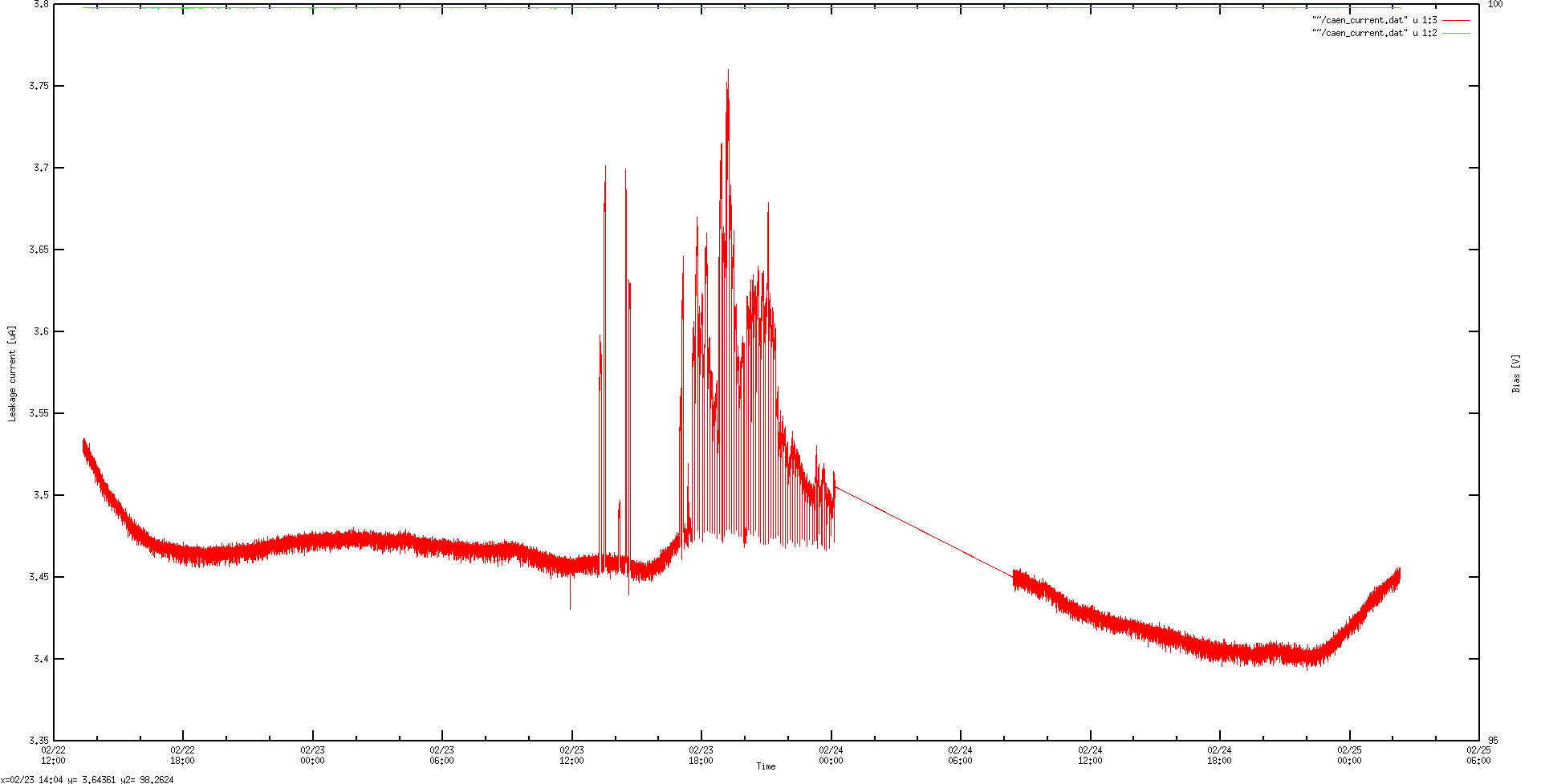
|
| Attachment 4: Screenshot_from_2022-02-25_02-16-54.png
|

|
| Attachment 5: Screenshot_from_2022-02-25_02-17-29.png
|

|
| Attachment 6: Screenshot_from_2022-02-25_02-17-39.png
|

|
| Attachment 7: Screenshot_from_2022-02-25_02-17-57.png
|
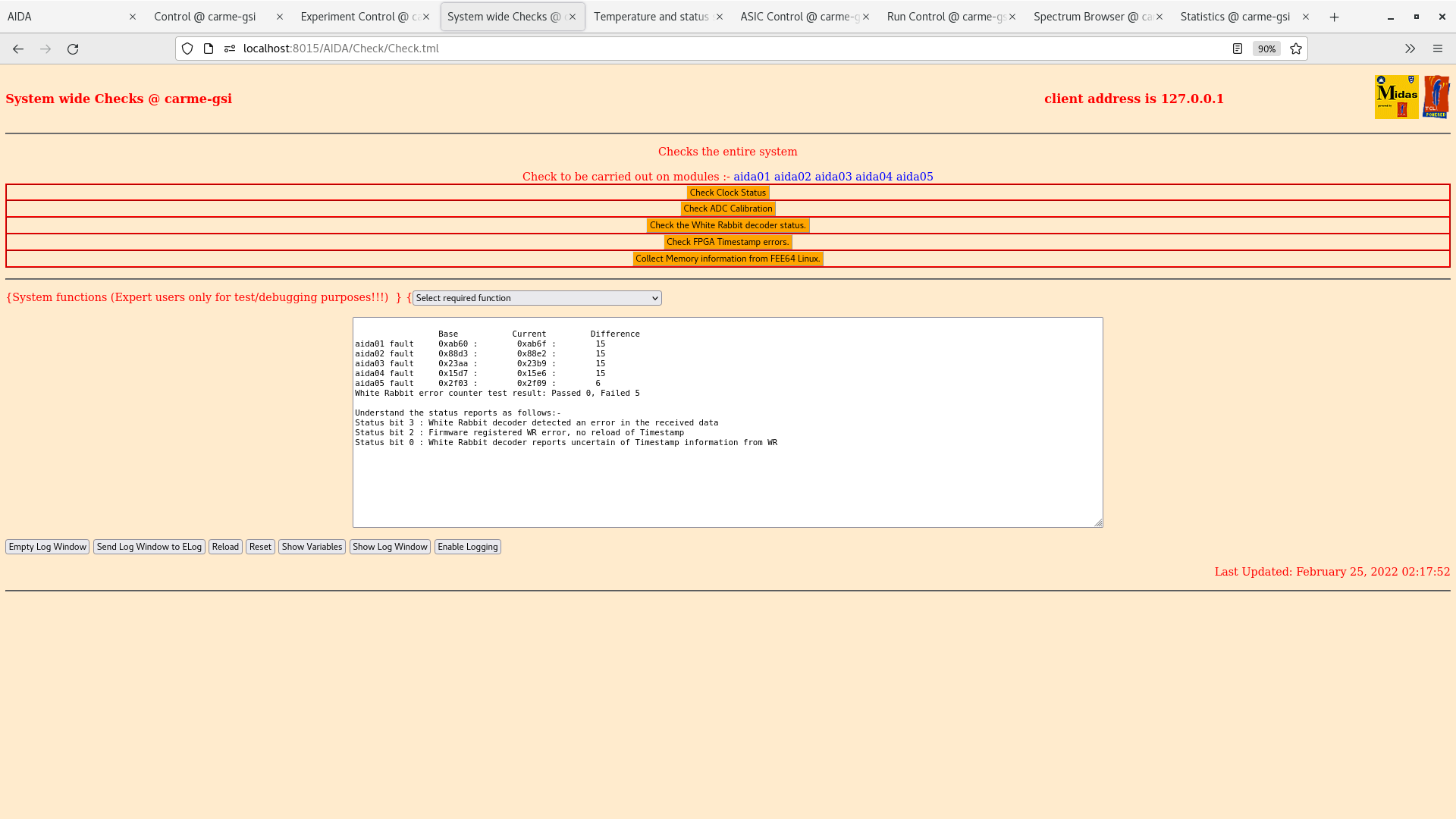
|
| Attachment 8: Screenshot_from_2022-02-25_02-19-05.png
|
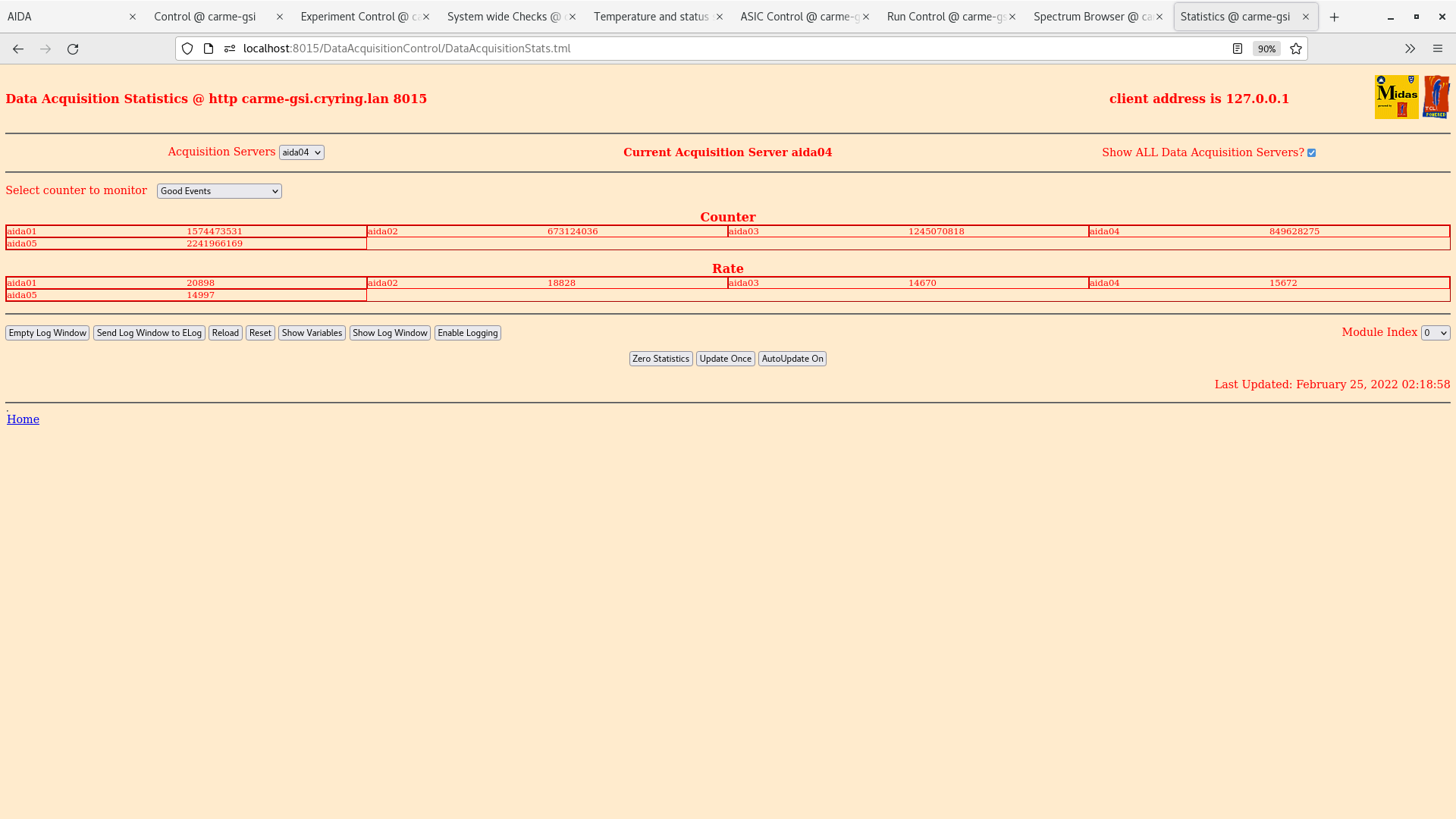
|
| Attachment 9: Screenshot_from_2022-02-25_02-19-17.png
|
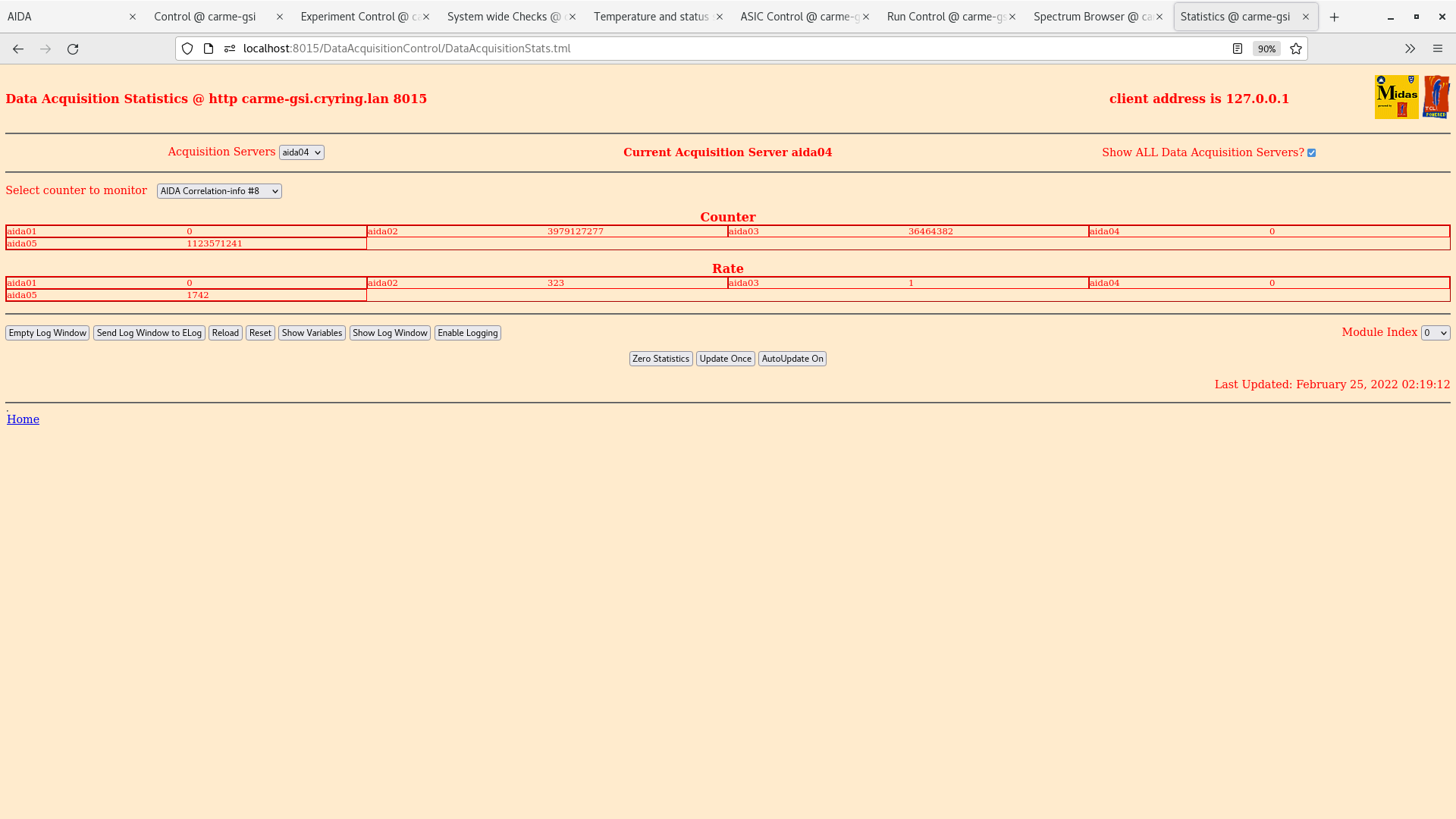
|
| Attachment 10: Screenshot_from_2022-02-25_02-20-01.png
|

|
| Attachment 11: Screenshot_from_2022-02-25_02-21-36.png
|

|
| Attachment 12: Screenshot_from_2022-02-25_02-22-17.png
|

|
| Attachment 13: Screenshot_from_2022-02-25_02-23-40.png
|
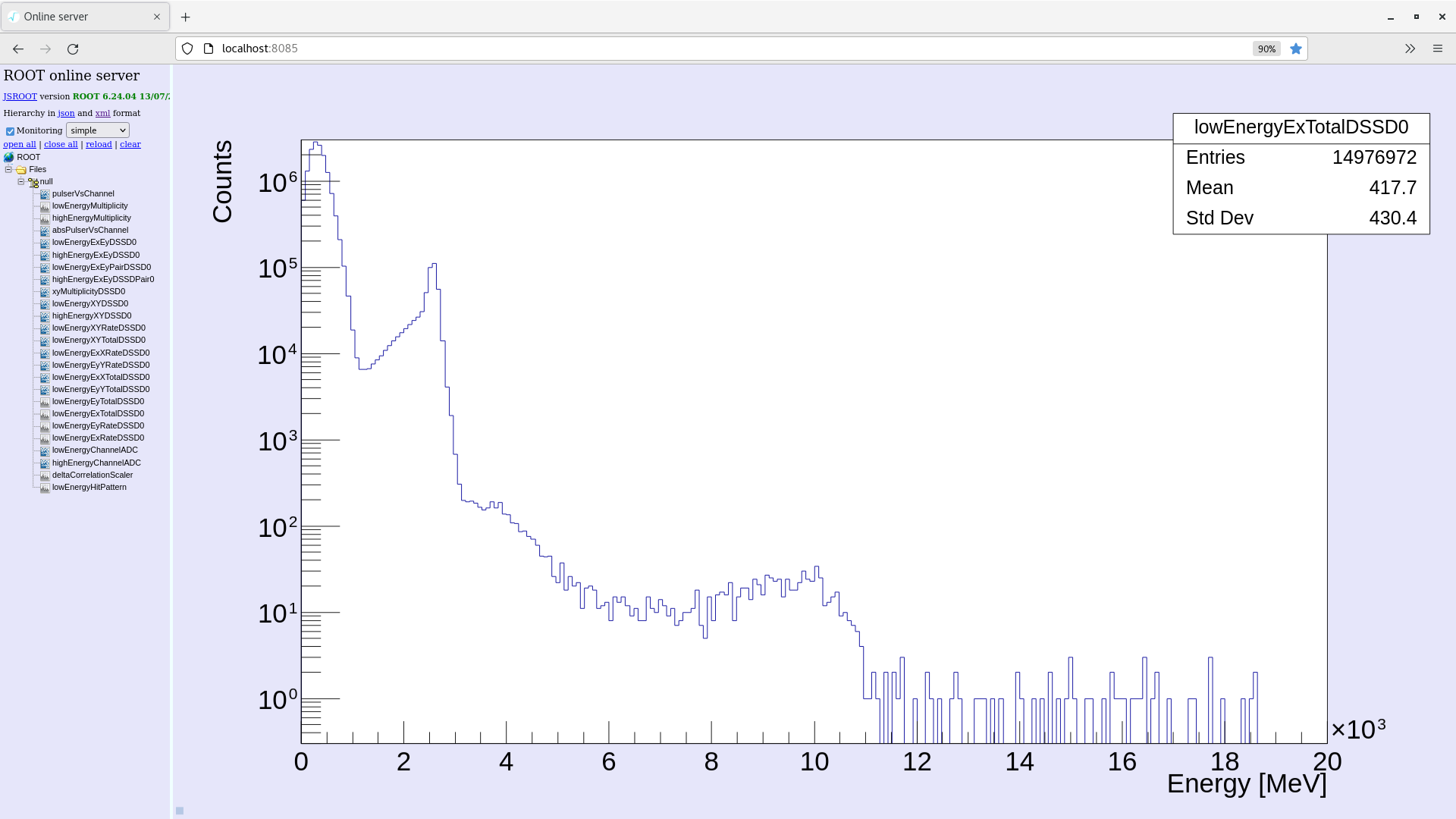
|
|
273
|
Fri Feb 25 00:00:40 2022 |
Rui-Jiu Chen, Alex | Check |
There are some problems with ion source. No beam in CRYING.
Motor fully out position.
SW3
- Merger OK
- Screenshot uploaded
- Data rate : 230 kbytes/s
SW4
- current plot uploaded
SW2
- T OK
- system wide checks OK
- Check statistics tab ok
- Spectra ok
SW5
4 plots uploaded |
| Attachment 1: Screenshot_from_2022-02-25_01-02-48.png
|

|
| Attachment 2: Screenshot_from_2022-02-25_01-02-58.png
|

|
| Attachment 3: Screenshot_from_2022-02-25_01-04-09.png
|
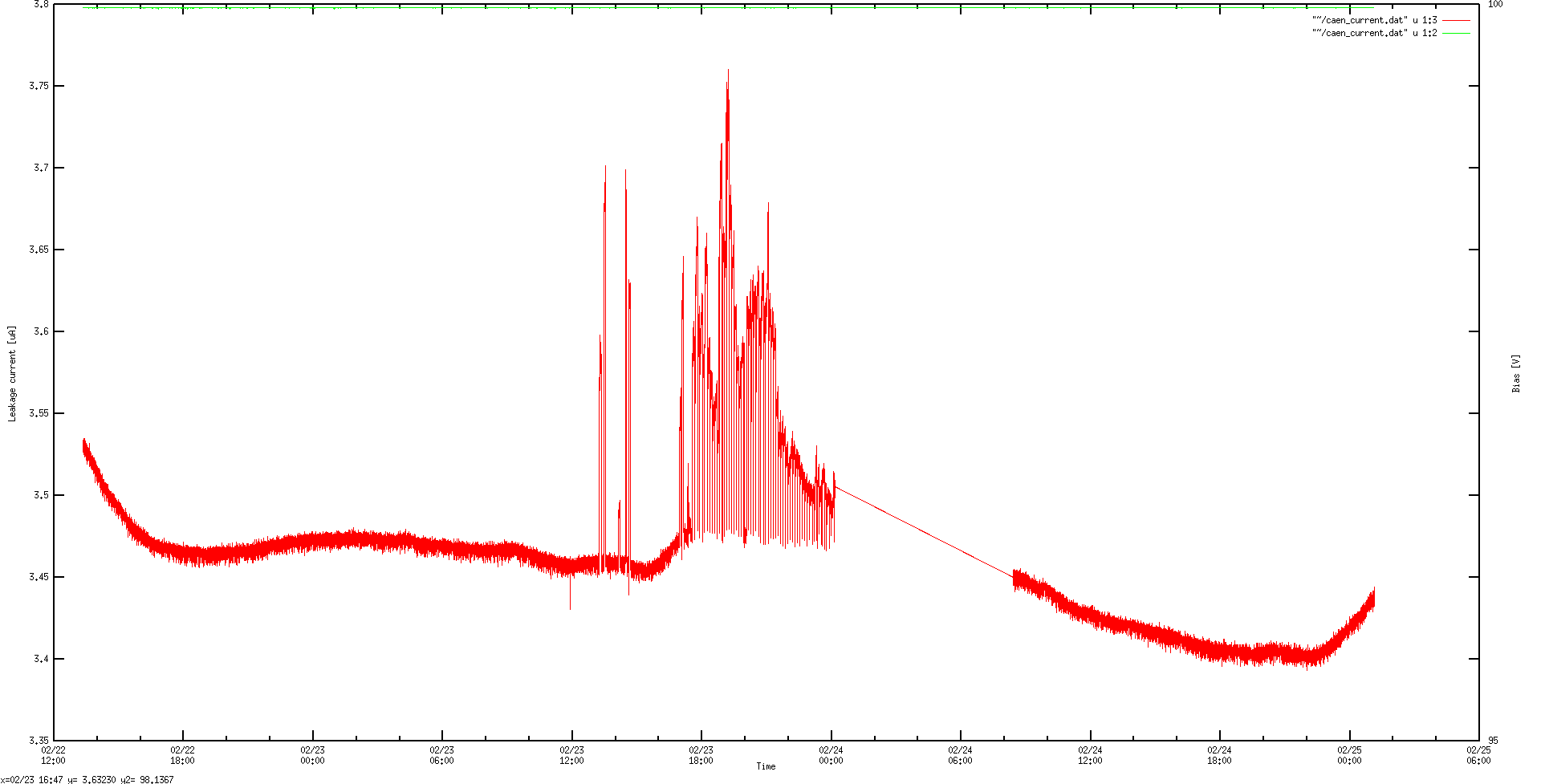
|
| Attachment 4: Screenshot_from_2022-02-25_01-06-45.png
|
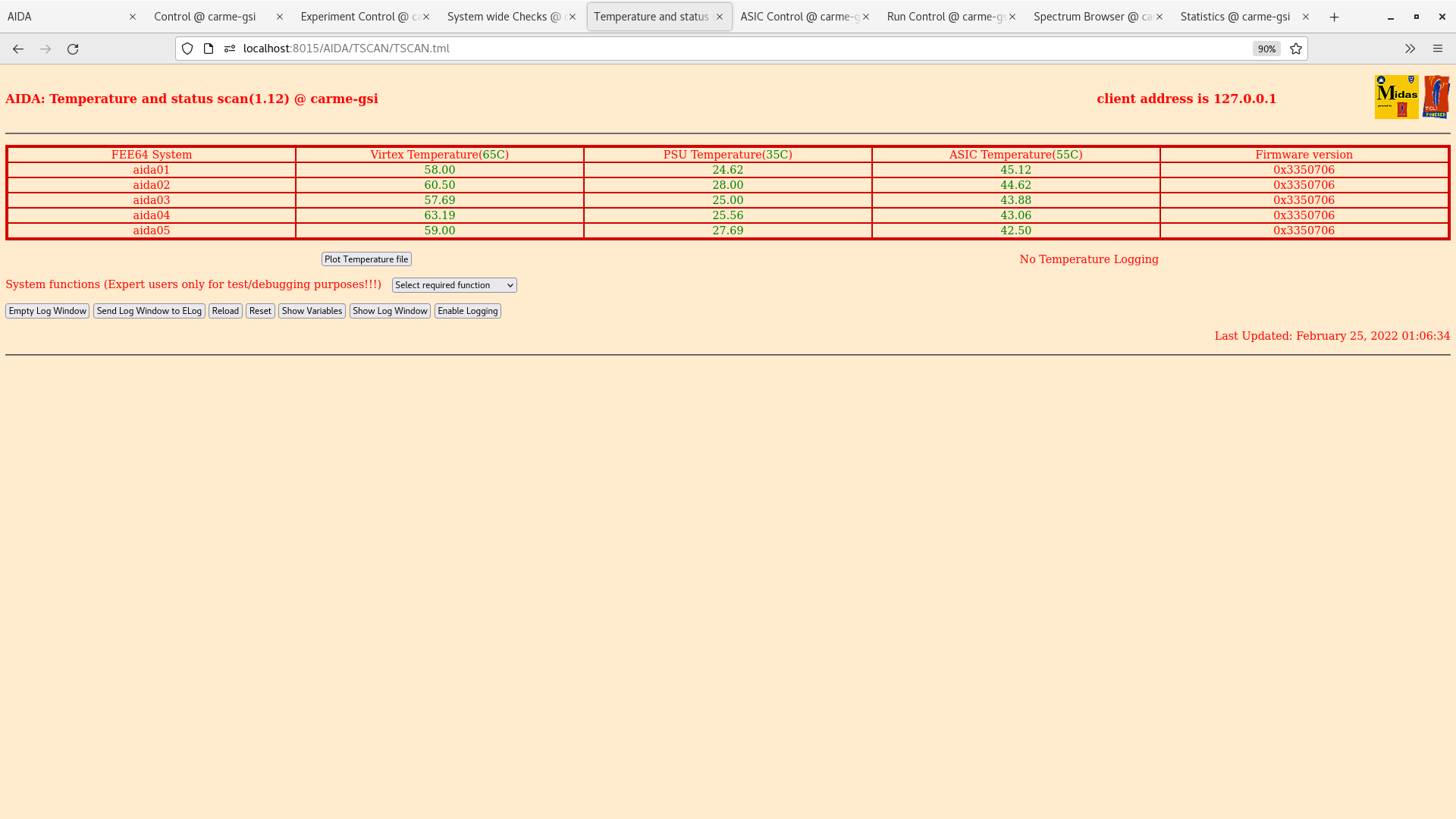
|
| Attachment 5: Screenshot_from_2022-02-25_01-07-30.png
|
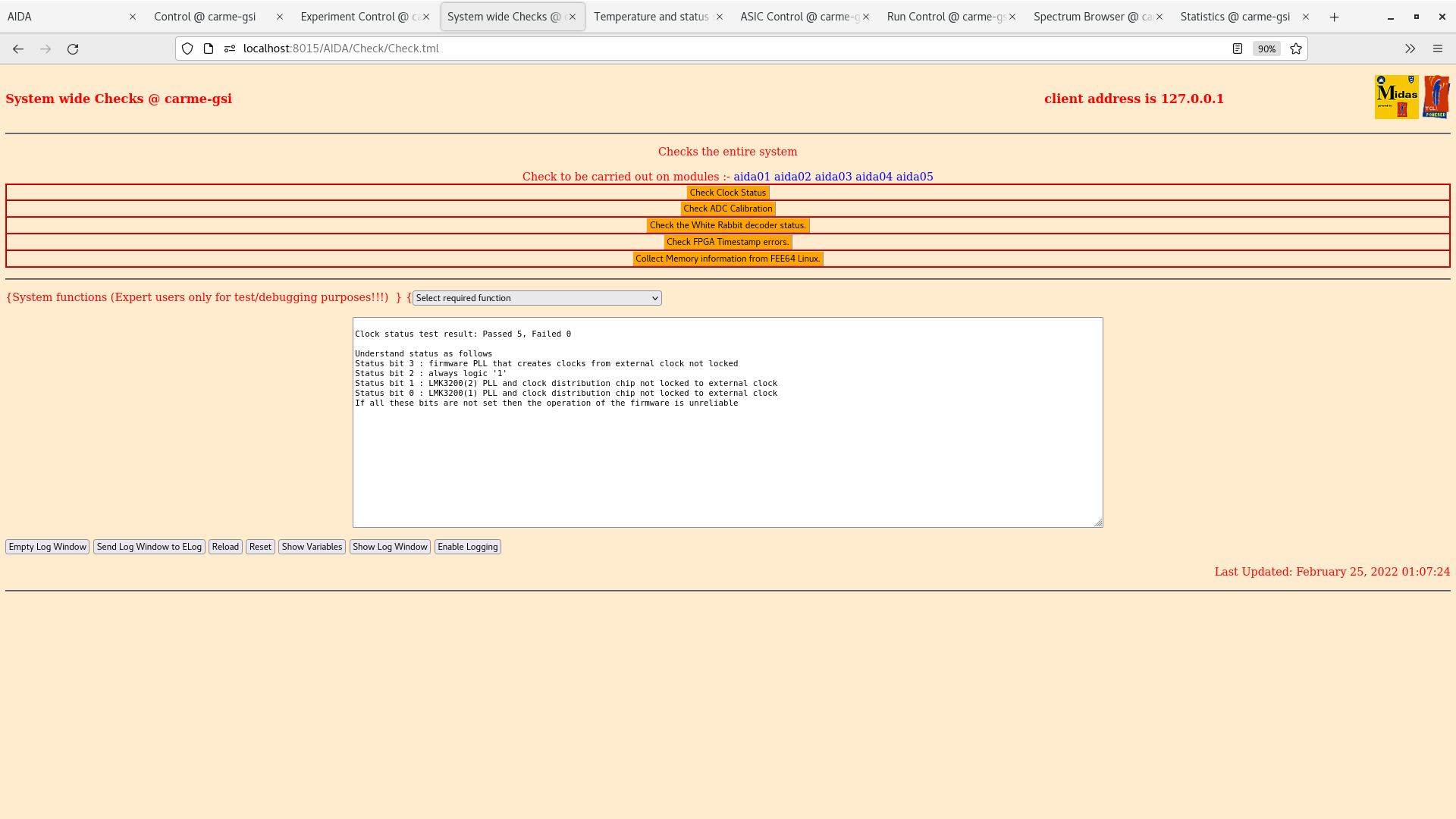
|
| Attachment 6: Screenshot_from_2022-02-25_01-07-55.png
|

|
| Attachment 7: Screenshot_from_2022-02-25_01-08-22.png
|
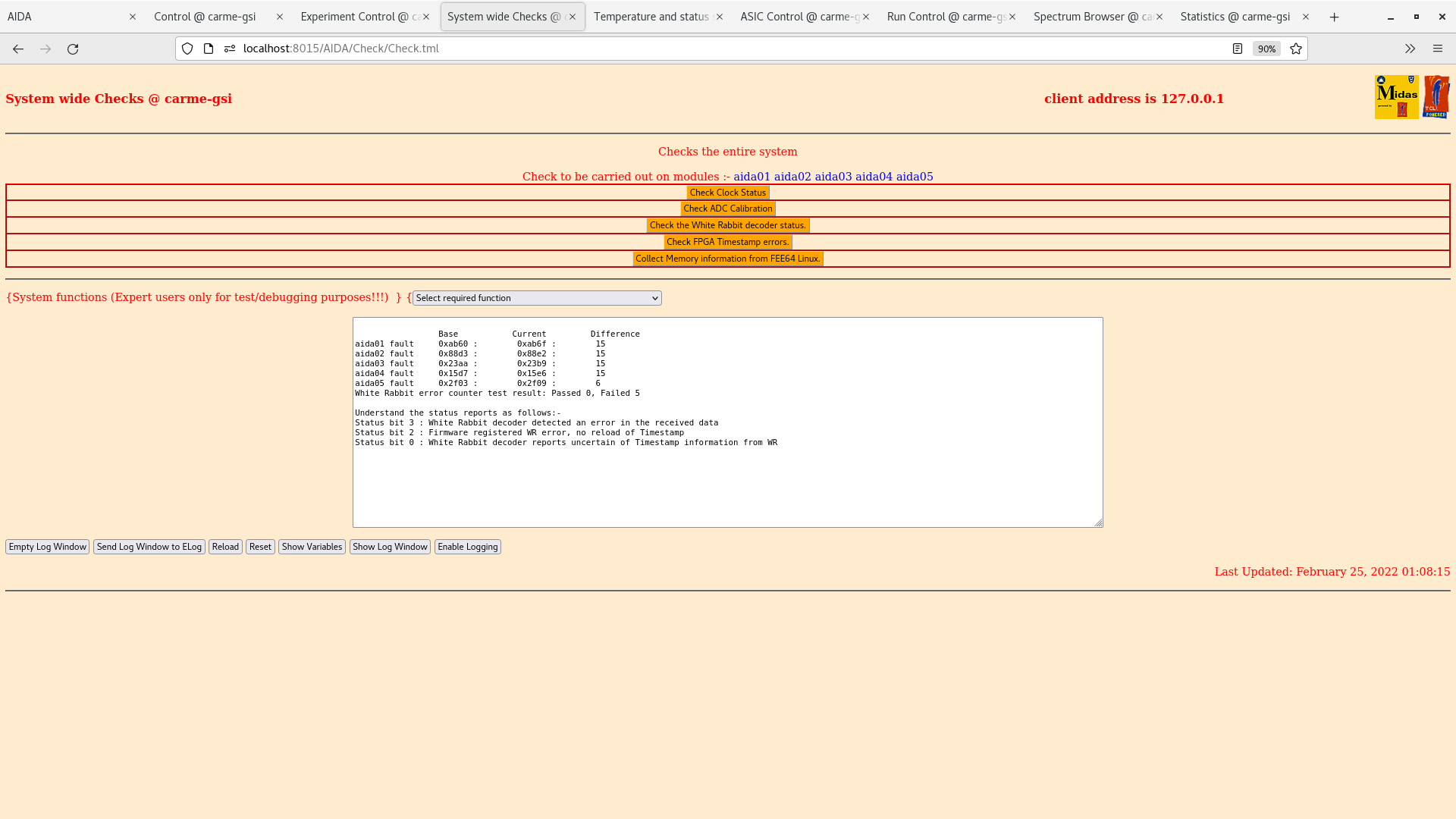
|
| Attachment 8: Screenshot_from_2022-02-25_01-09-24.png
|
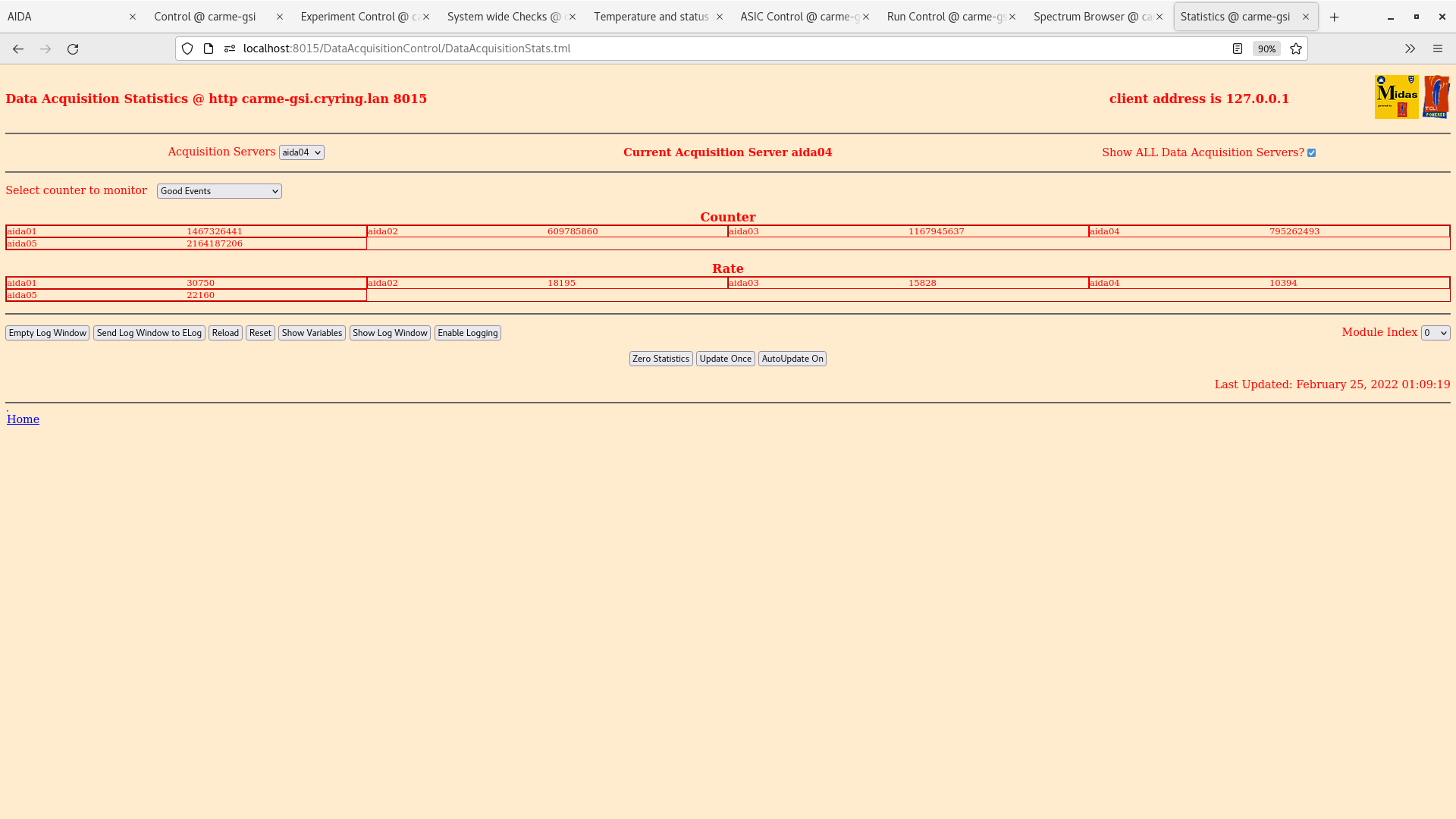
|
| Attachment 9: Screenshot_from_2022-02-25_01-10-03.png
|

|
| Attachment 10: Screenshot_from_2022-02-25_01-12-00.png
|
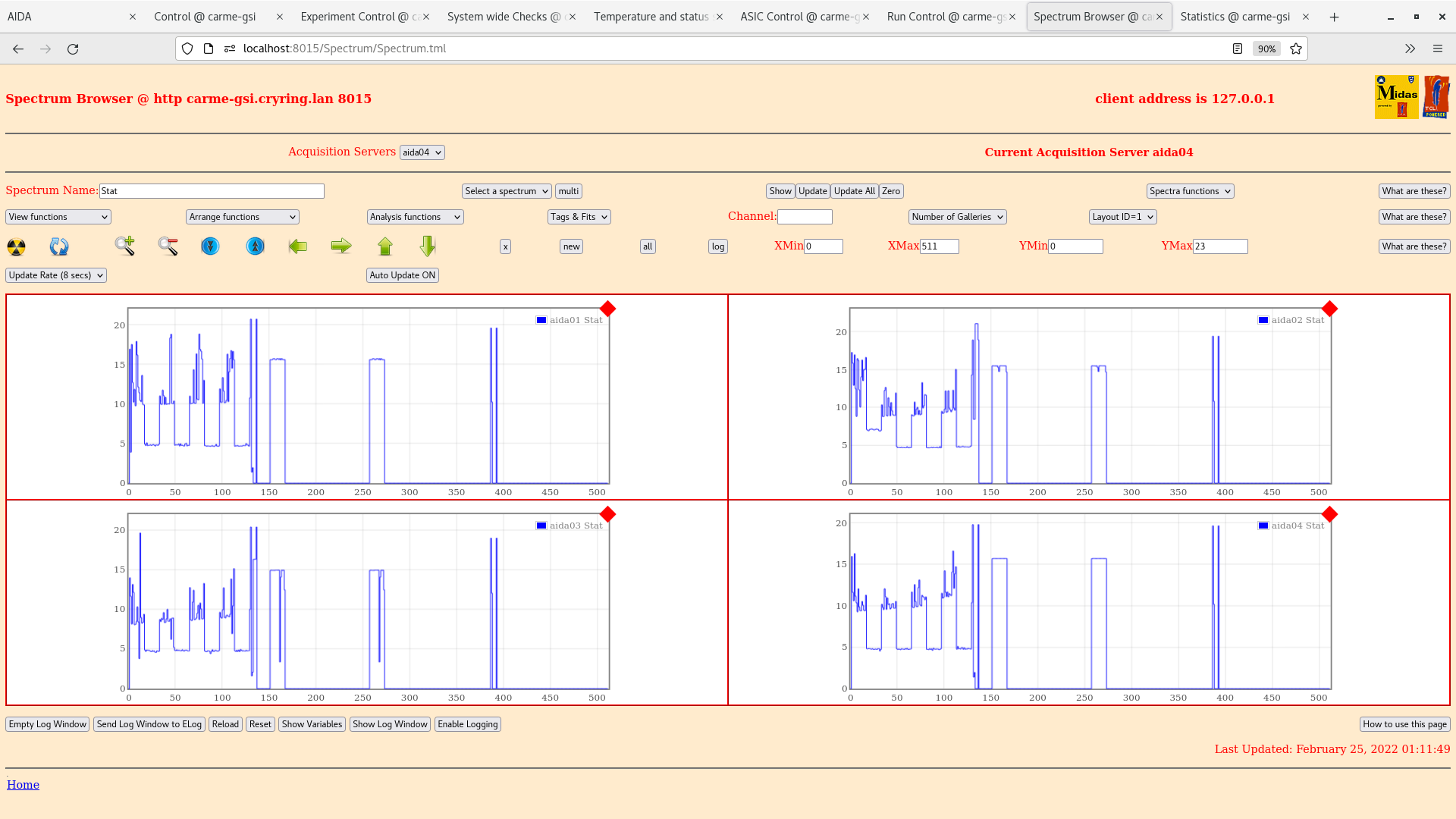
|
| Attachment 11: Screenshot_from_2022-02-25_01-15-34.png
|

|
| Attachment 12: Screenshot_from_2022-02-25_01-16-22.png
|

|
| Attachment 13: Screenshot_from_2022-02-25_01-17-24.png
|
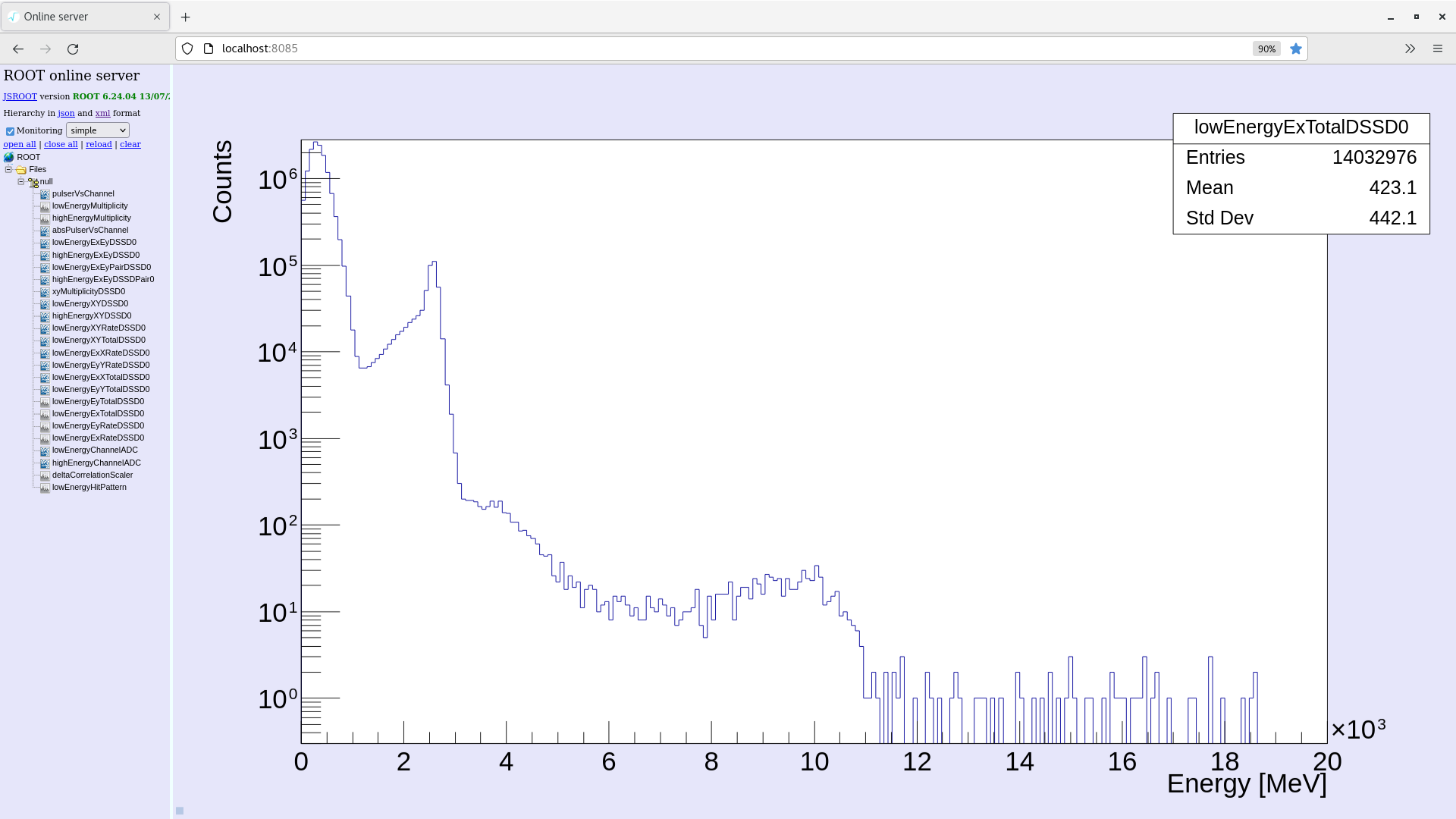
|
| Attachment 14: Screenshot_from_2022-02-25_01-17-58.png
|
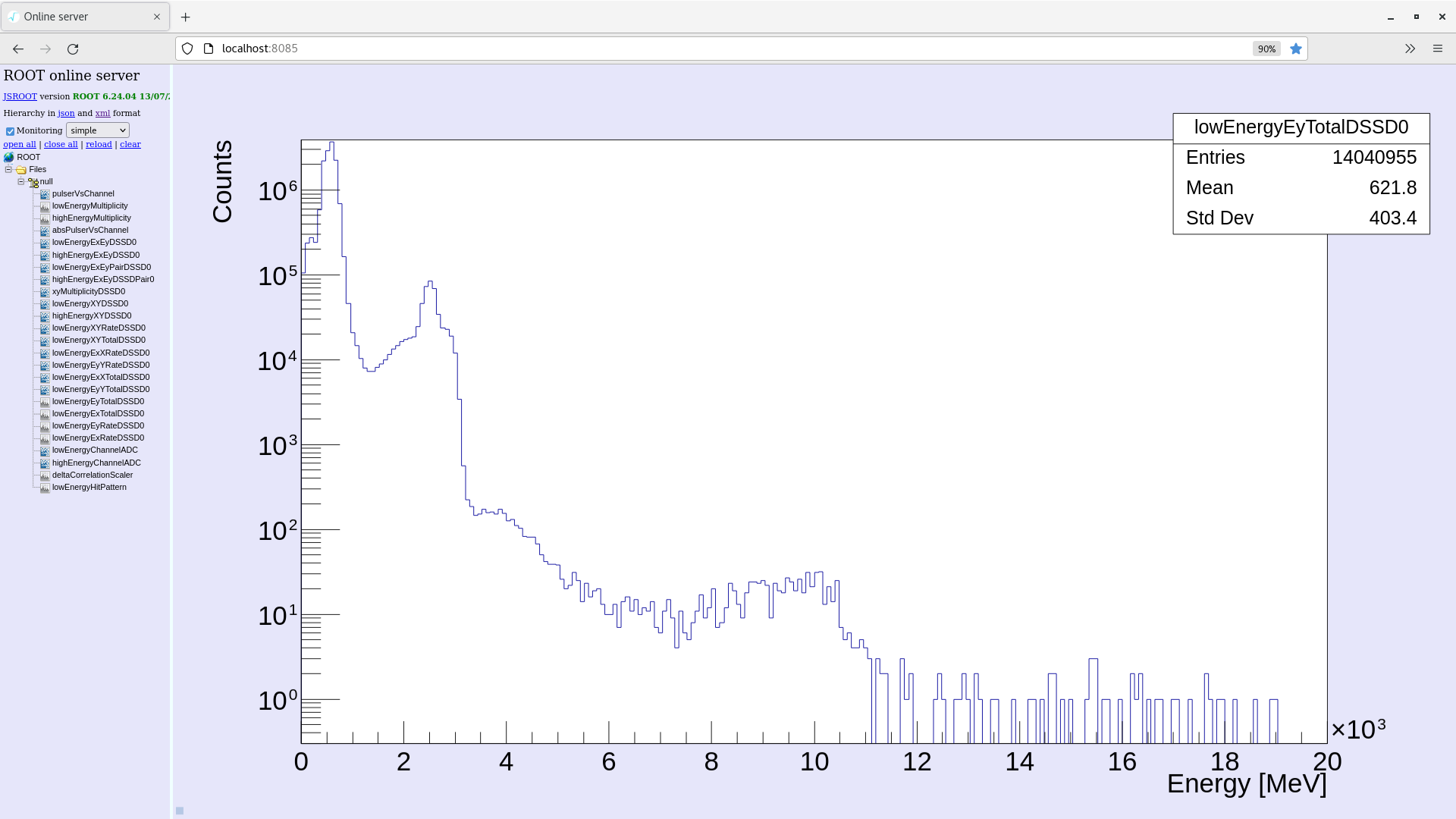
|
|
272
|
Thu Feb 24 23:15:25 2022 |
Rui-Jiu Chen, Alex | Problems with ion souce. |
|
|
271
|
Thu Feb 24 22:45:08 2022 |
Jordan, George, Rui-Jiu Chen | check |
- Motor fully out position.
SW3
- Merger OK
- Screenshot uploaded
- Data rate : 236 kbytes/s
SW4
- current plot uploaded
SW2
- T OK
- system wide checks OK
- Check statistics tab ok
- Spectra ok
SW5
4 plots uploaded
|
| Attachment 1: Screenshot_from_2022-02-24_23-49-31.png
|

|
| Attachment 2: Screenshot_from_2022-02-24_23-54-01.png
|
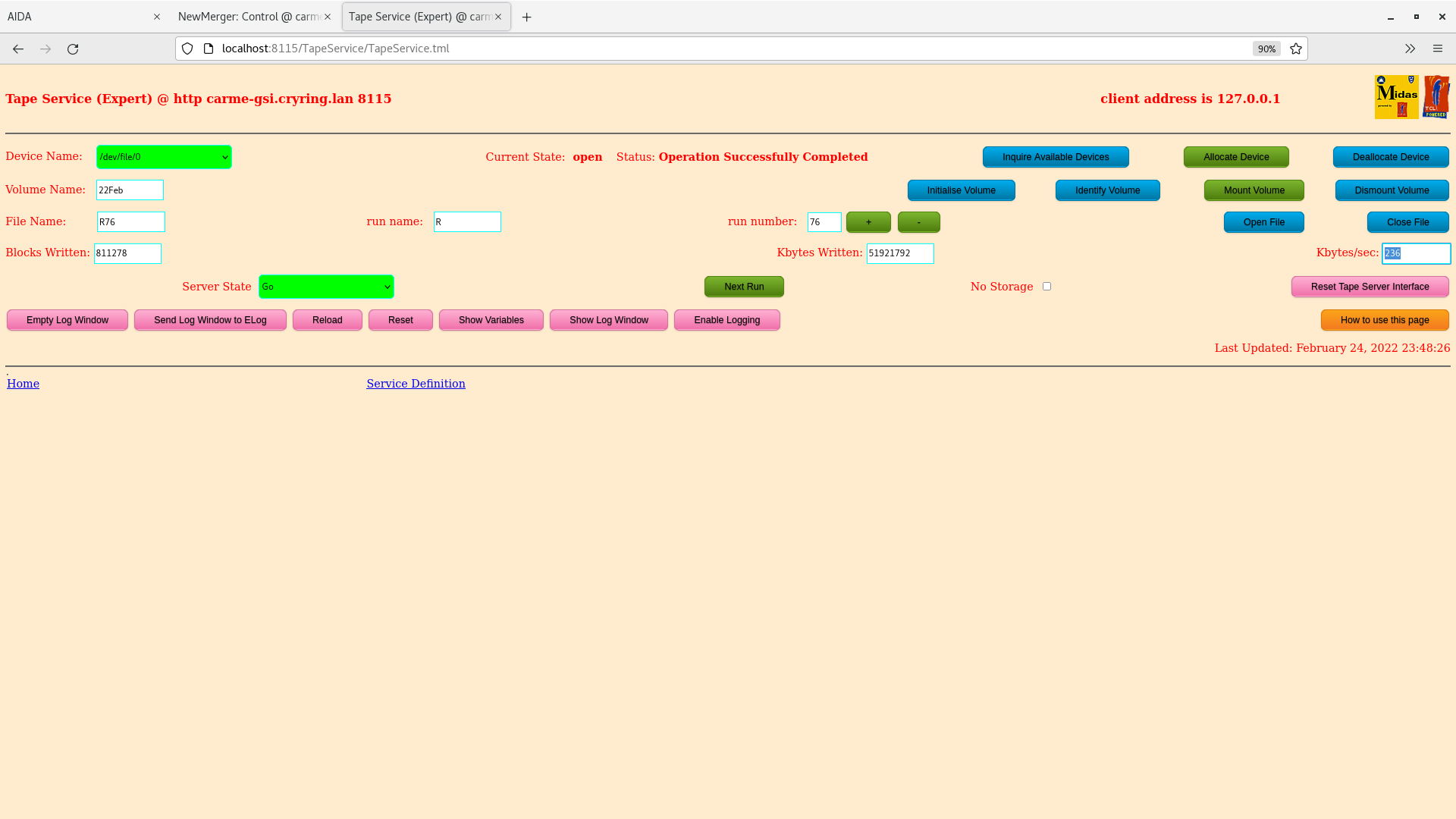
|
| Attachment 3: Screenshot_from_2022-02-24_23-54-57.png
|

|
| Attachment 4: Screenshot_from_2022-02-24_23-56-46.png
|
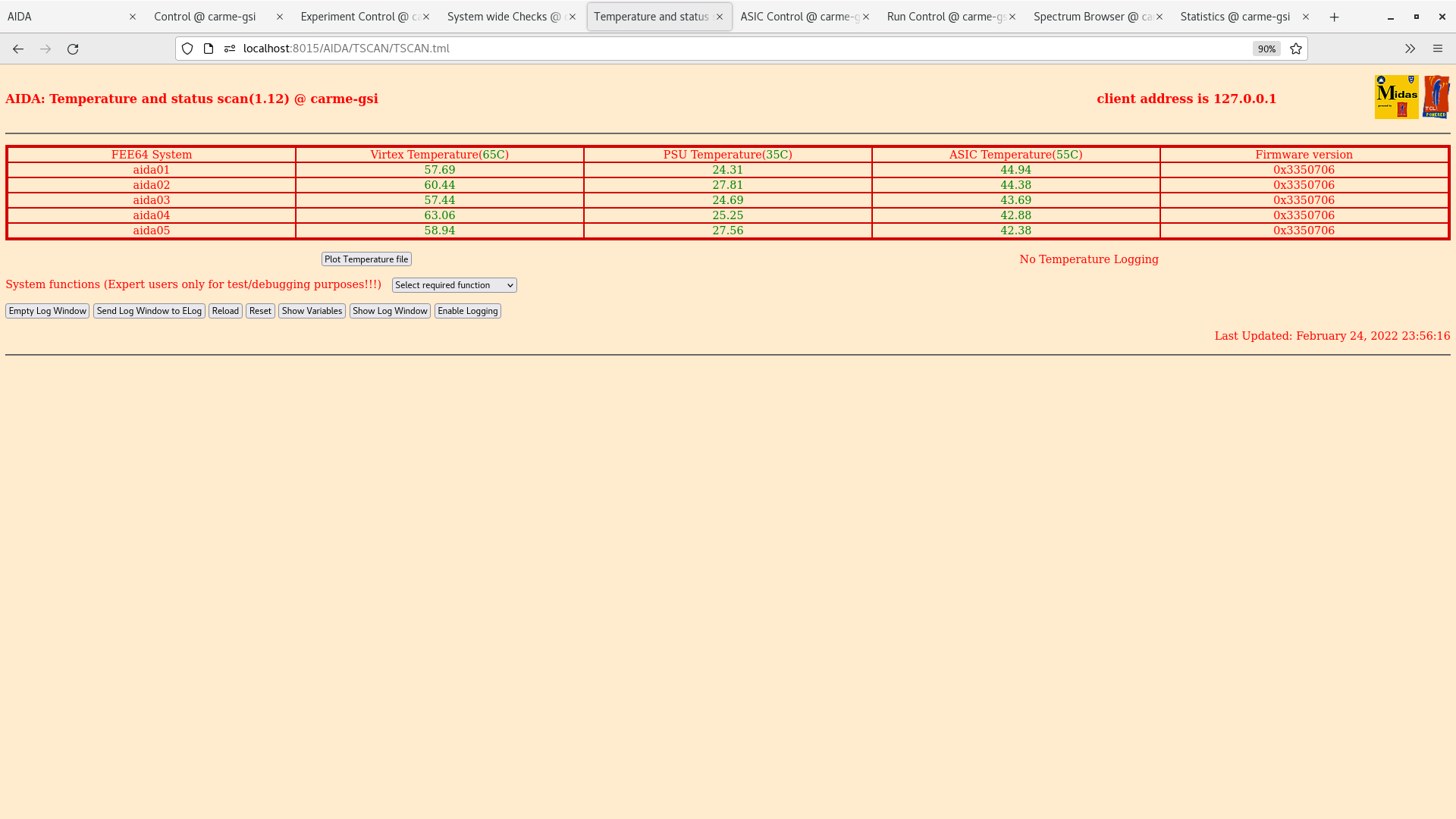
|
| Attachment 5: Screenshot_from_2022-02-24_23-58-18.png
|

|
| Attachment 6: Screenshot_from_2022-02-24_23-59-10.png
|

|
| Attachment 7: Screenshot_from_2022-02-24_23-59-32.png
|

|
| Attachment 8: Screenshot_from_2022-02-25_00-00-48.png
|

|
| Attachment 9: Screenshot_from_2022-02-25_00-02-54.png
|

|
| Attachment 10: Screenshot_from_2022-02-25_00-04-35.png
|

|
| Attachment 11: Screenshot_from_2022-02-25_00-09-26.png
|
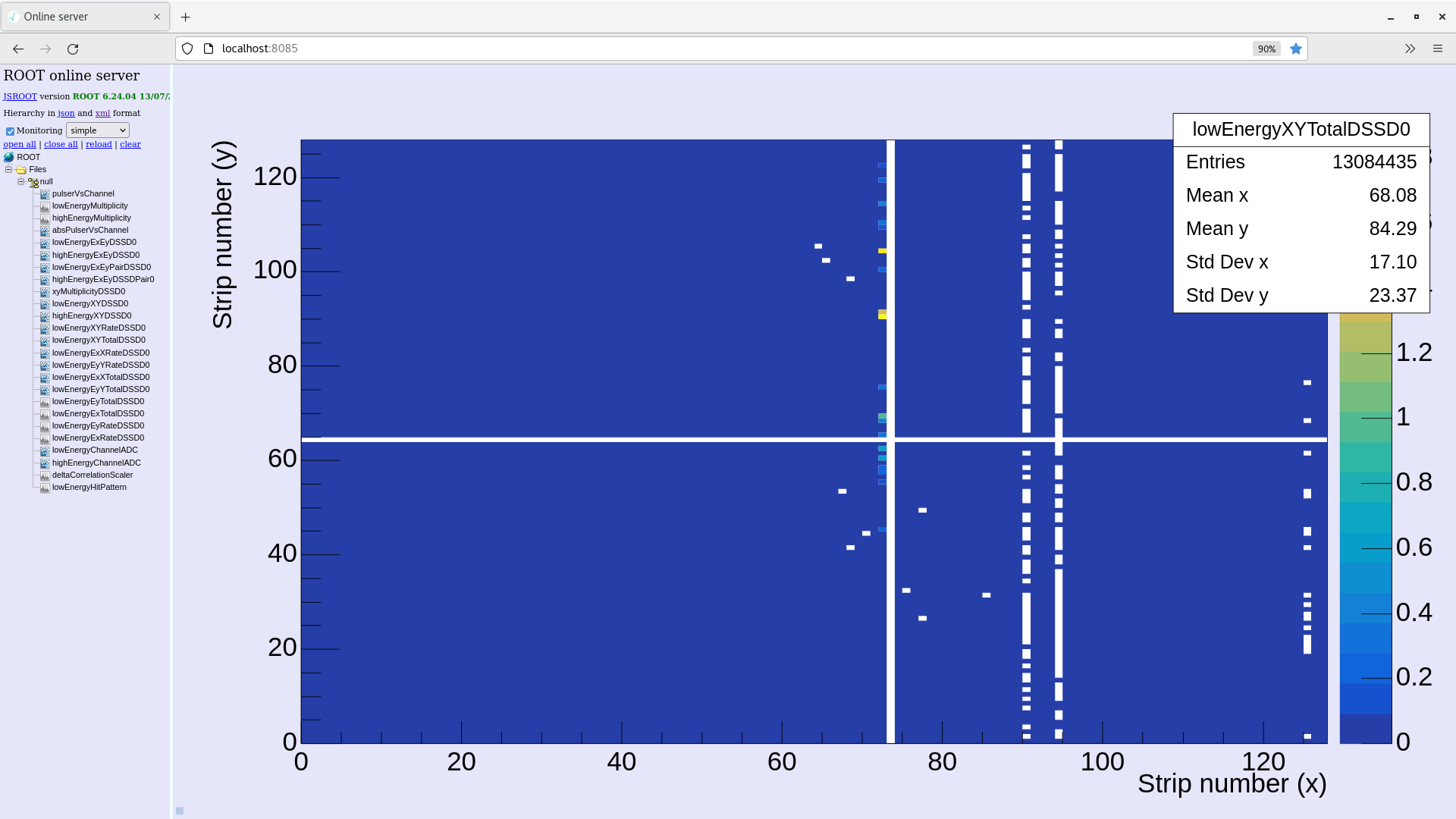
|
| Attachment 12: Screenshot_from_2022-02-25_00-11-10.png
|

|
| Attachment 13: Screenshot_from_2022-02-25_00-13-30.png
|

|
| Attachment 14: Screenshot_from_2022-02-25_00-14-11.png
|

|
|
270
|
Thu Feb 24 14:31:25 2022 |
JM, ML, CN | Beam Tuning Run 76 |
15:30
1.5 MeV/u beam currently being tuned
Target is ON, setpoint = 135 K
System checks OK - white rabbit fail diff ~ 9
Temperatures OK
Merger OK
Data rate ~ 1400 kb/sec
Leakage current ~ 3.41 uA
Aida 1 and 2 missing channels from previous days appear working on stat layout 2 and xy pixel total plot (attachment 3)
17:12
Beam tuning complete. See attached Ex rate histogram.
The cryo compressor is being turned OFF for around 1 hour to remove any frozen nitrogen which may be the cause of the increased pressures observed.
Beam OFF to do so.
System checks OK - white rabbit fail diff ~ 9
Temperatures OK
Merger OK
Data rate ~ 200 kb/sec
Compressor OFF, setpoint on controller is 273 K
18:51
Pressure in the ring recovered quickly after closing valves to gas jet (attachment 5)
Increasing temperature caused a large spike in pressure in the inlets. E1 turbo briefly shut down due to the pressure increase, since restarted and pressure back in the -4 mbar range. (attachment 6)
Temperature being decreased
Beam back ON
data rate ~ 1500 kb/sec
merger OK
Temperatures OK
System checks OK - white rabbit diff ~ 12
21:58
After cooling the jet target, expected density is not achieved. E4 pressure is ~4E-10 mbar compared to ~2E-8mbar previously. Temperature reduced to 127K E4 pressure increases however stilll within -10 mbar range.
With beam on target we see rutherford peak at ~3 MeV, however it is much reduced.
Beam OFF to investigate inside the cave.
Decreasing temperature of nozzle in 0.5 k steps to see effect on E4 and S1 dump.
|
| Attachment 1: 2022-02-24_15-35-53-Ex-rate-histogram.png
|
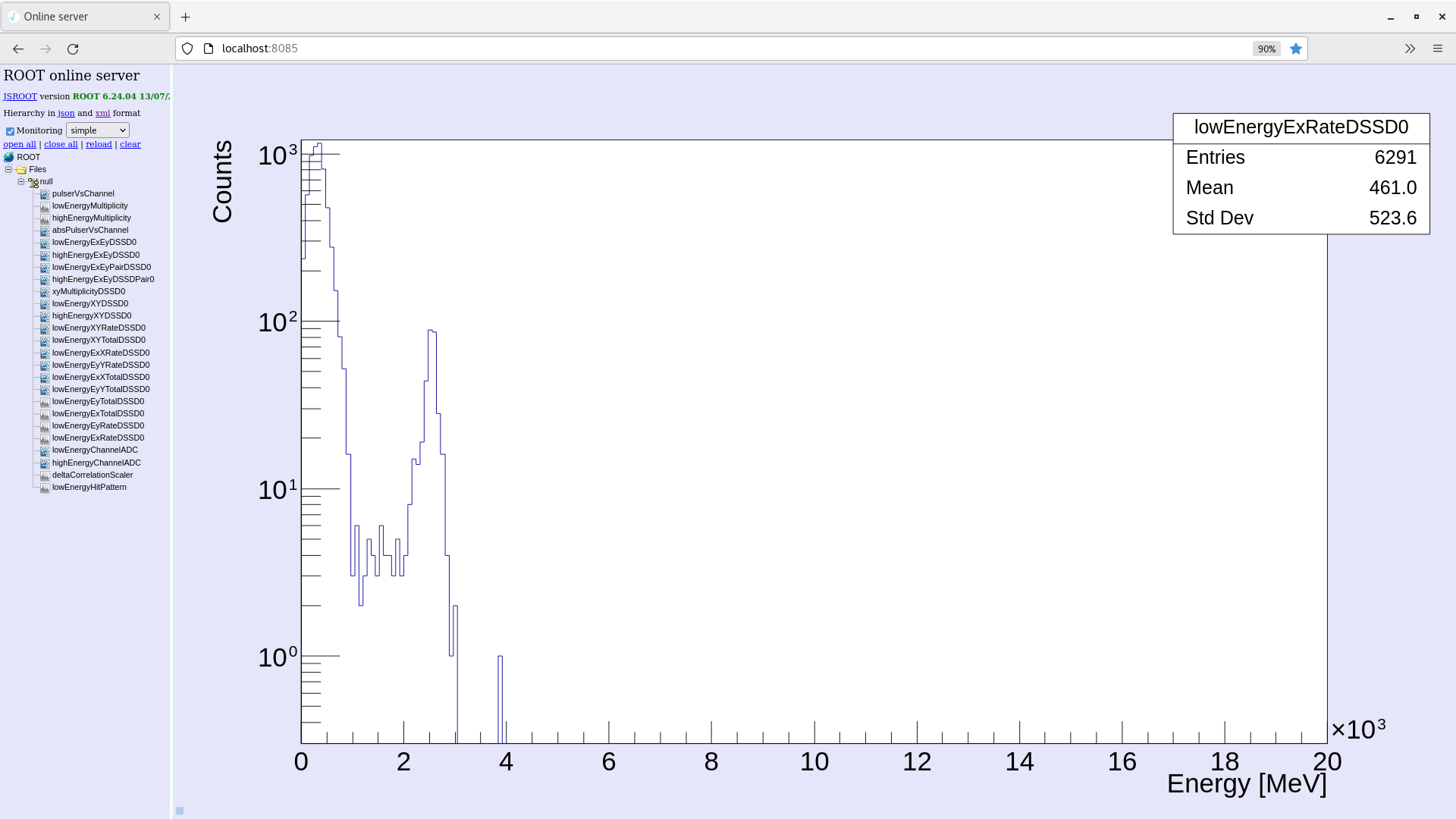
|
| Attachment 2: 2022-02-24_15-39-08-leakage-current.png
|
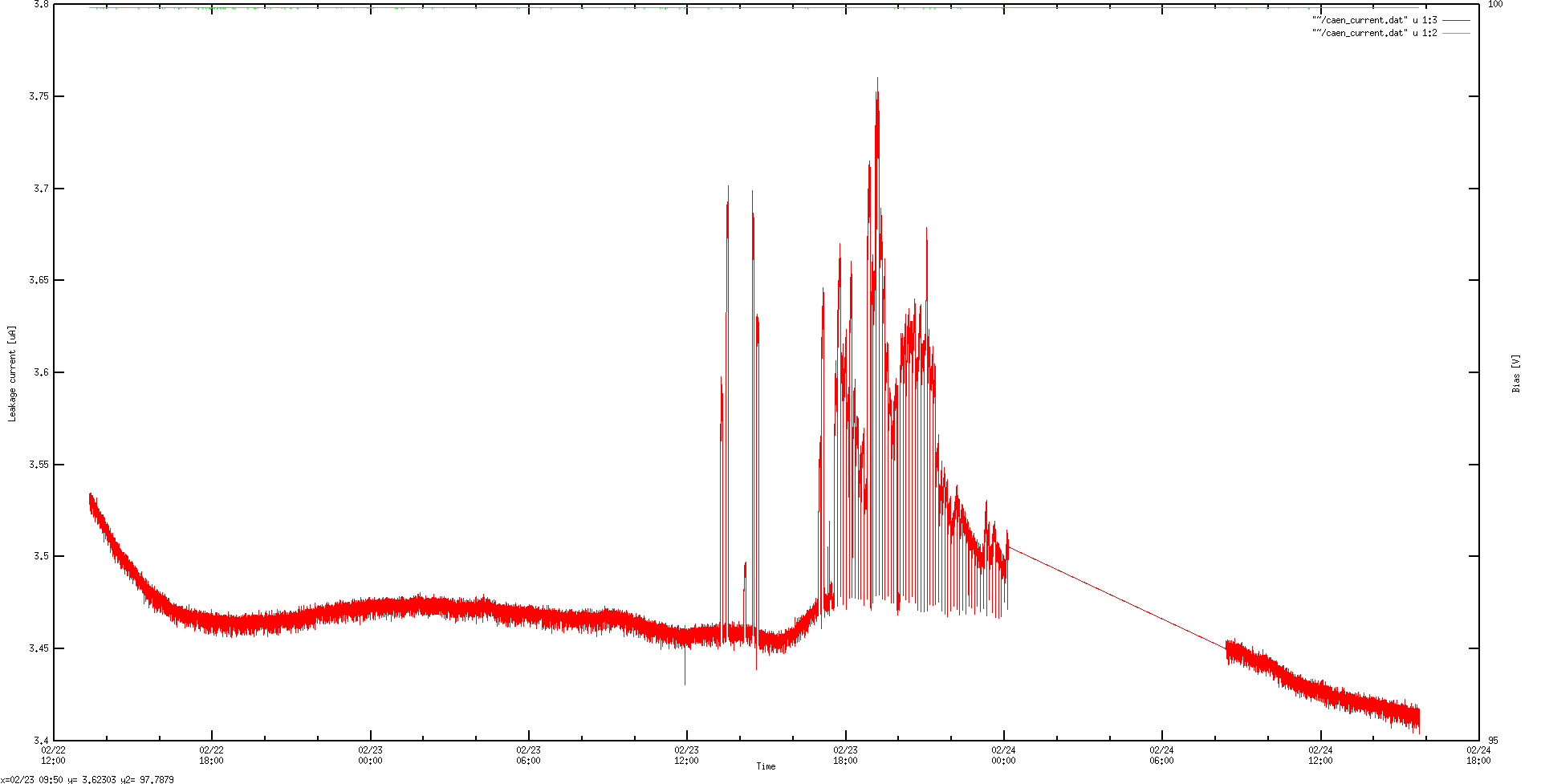
|
| Attachment 3: 2022-02-24_15-44-06-aida1-5-stat.png
|
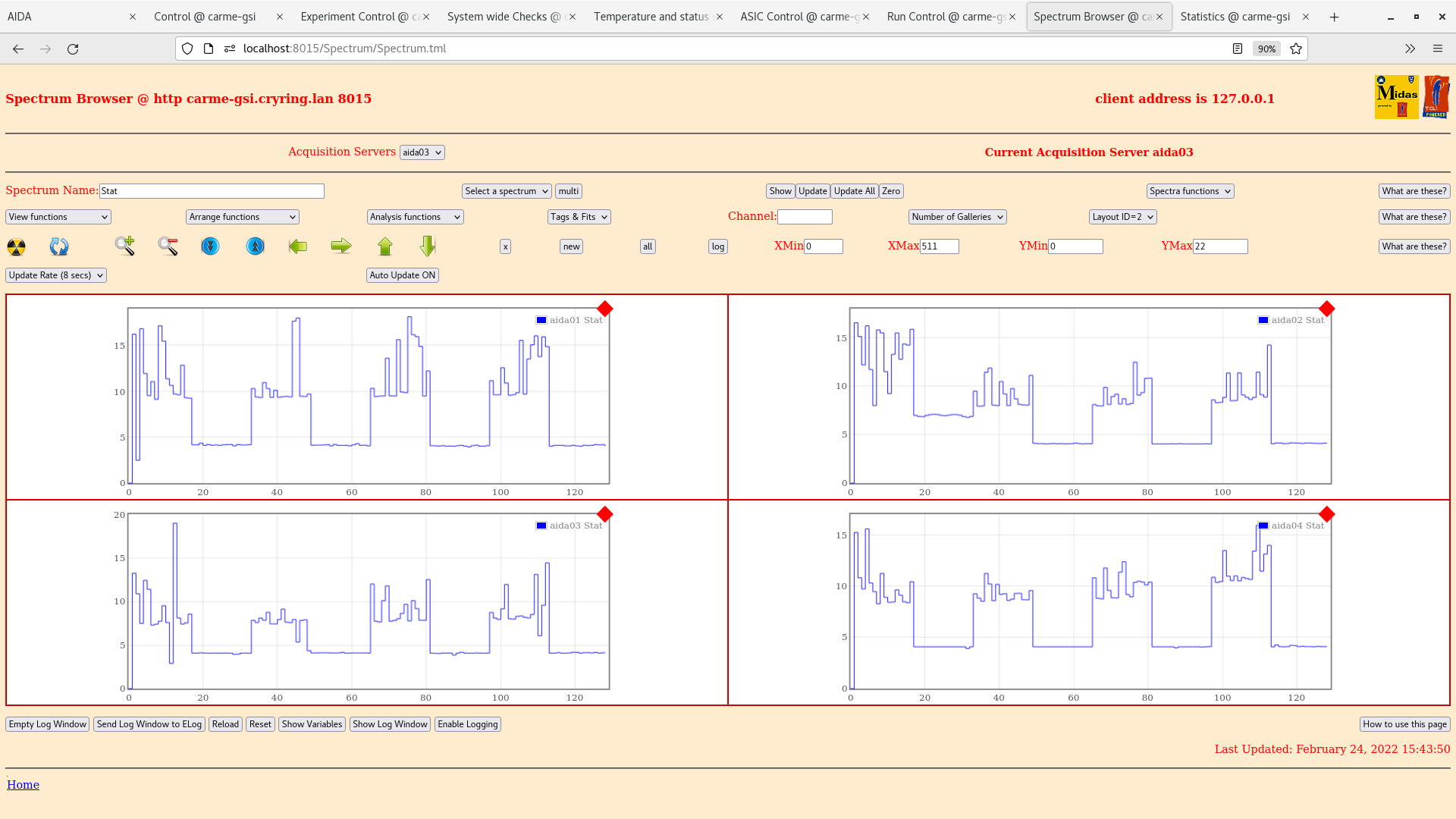
|
| Attachment 4: 2022-02-24_17-07-52-xyTotal.png
|

|
| Attachment 5: vacplot24.png
|
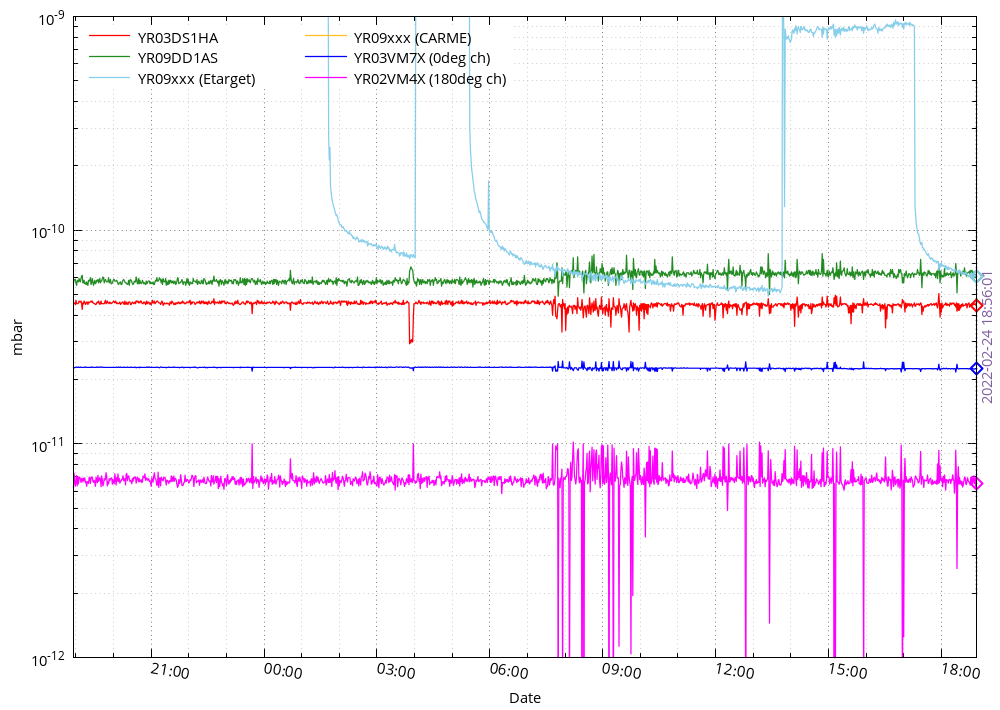
|
| Attachment 6: gasjet-vacplot.png
|

|
|
269
|
Thu Feb 24 09:43:16 2022 |
JG, MS | check |
Beam is still beeing tuned. Target is off.
- Motor on manual
SW3
- Merger OK
- Screenshot uploaded
- Data rate : 947 kbytes/s
SW4
- current plot uploaded
SW2
- T OK
- system wide checks OK
- Spectra ok
SW5
4 plots uploaded
|
| Attachment 1: Screenshot_from_2022-02-24_10-42-50.png
|

|
| Attachment 2: Screenshot_from_2022-02-24_10-42-29.png
|

|
| Attachment 3: Screenshot_from_2022-02-24_10-42-13.png
|

|
| Attachment 4: Screenshot_from_2022-02-24_10-41-45.png
|
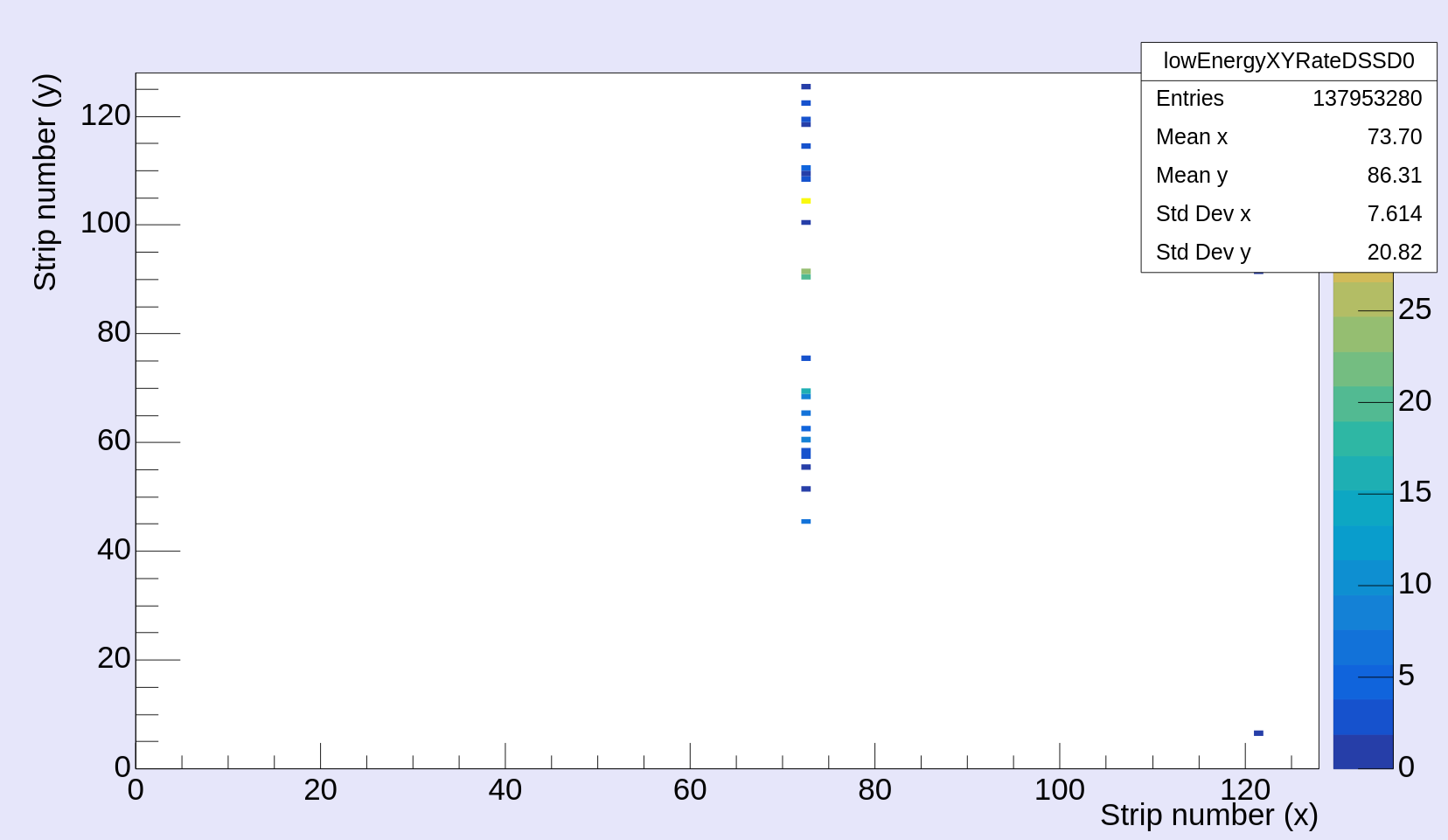
|
| Attachment 5: Screenshot_from_2022-02-24_10-41-27.png
|

|
| Attachment 6: Screenshot_from_2022-02-24_10-41-04.png
|
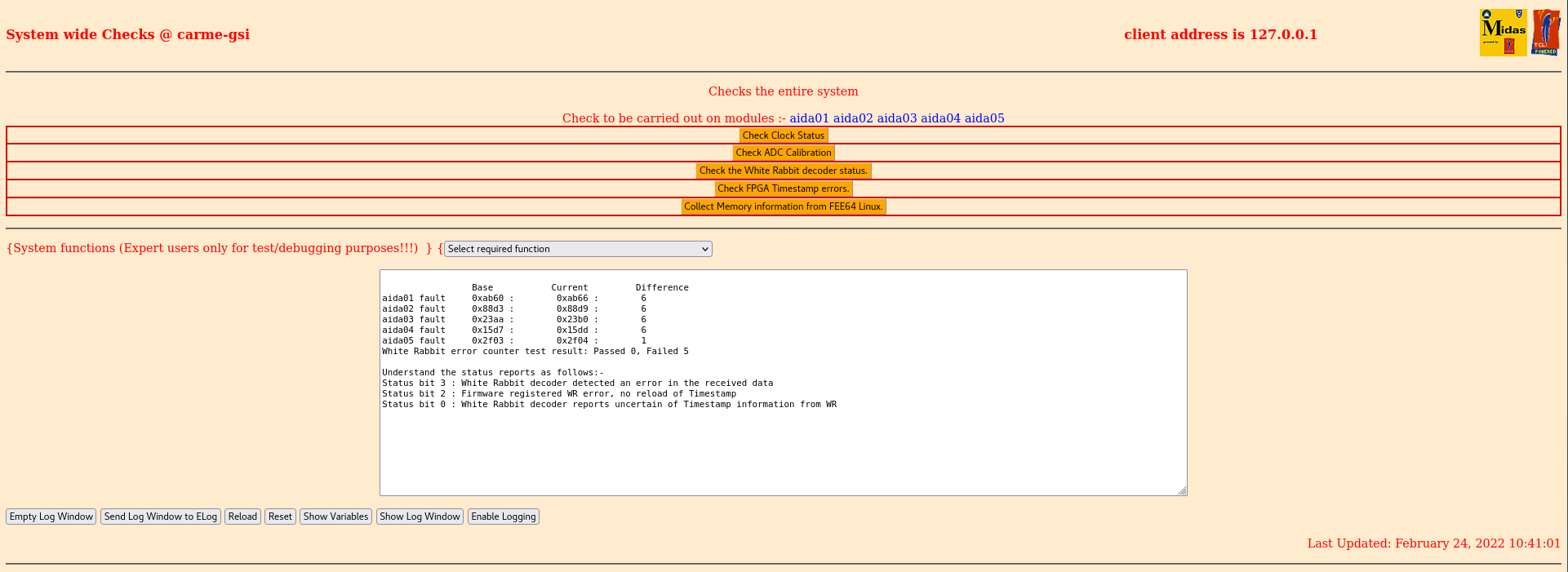
|
| Attachment 7: Screenshot_from_2022-02-24_10-40-53.png
|

|
| Attachment 8: Screenshot_from_2022-02-24_10-40-42.png
|

|
| Attachment 9: Screenshot_from_2022-02-24_10-40-26.png
|

|
| Attachment 10: Screenshot_from_2022-02-24_10-40-02.png
|

|
| Attachment 11: Screenshot_from_2022-02-24_10-39-37.png
|

|
| Attachment 12: Screenshot_from_2022-02-24_10-39-22.png
|

|
| Attachment 13: Screenshot_from_2022-02-24_10-39-10.png
|

|
|
268
|
Thu Feb 24 08:30:36 2022 |
JG, MS | AIDA5 calibration test failed - solved |
UPDATE: THE PROBLEM IS SOLVED FOR NOW:
Doing the calib for the 5th time eventually worked.
------------
The ADC check showed that the calib test for aida5 failed.
We tried to do the calibration as described in the fail message, but it seems to not work. See attachement. |
| Attachment 1: Screenshot_from_2022-02-24_09-09-36.png
|

|
| Attachment 2: Screenshot_from_2022-02-24_09-29-24.png
|

|
|
267
|
Thu Feb 24 08:15:23 2022 |
JG, MS | check |
Beam is still beeing tuned. Target is off.
There is a problem with ADC calibration of aida5: see entry https://elog.ph.ed.ac.uk/CARME/268
- Motor on manual
SW3
- Merger OK
- Screenshot uploaded
- Data rate : ??? kbytes/s
SW4
- current plot uploaded
SW2
- T OK
- system wide check OK (ADC calibration test for AIDA5 failed, see above)
- Statistics ok
- Spectra ok
SW5
4 plots uploaded
|
| Attachment 1: Screenshot_from_2022-02-24_09-16-09.png
|
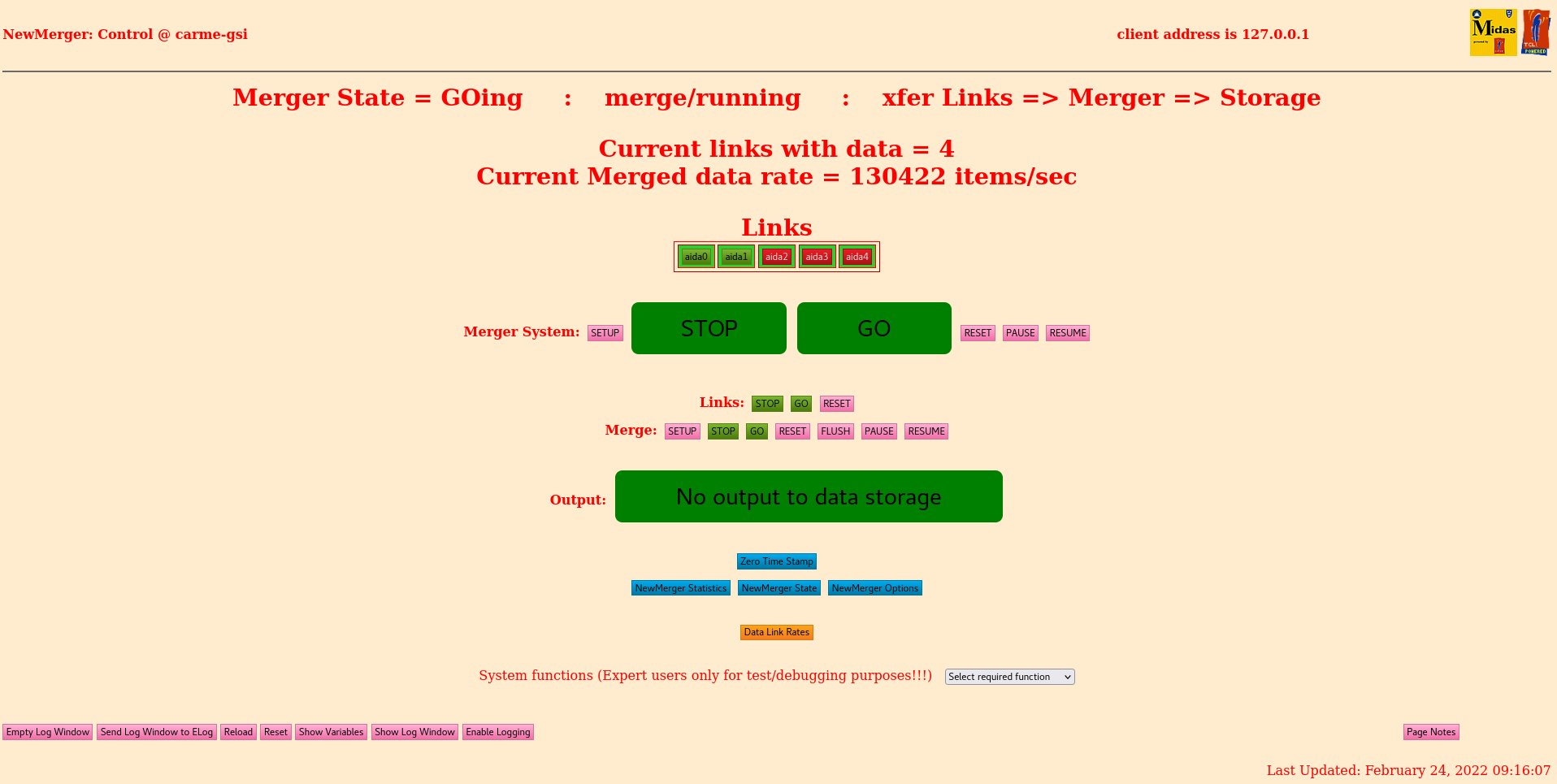
|
| Attachment 2: Screenshot_from_2022-02-24_09-14-51.png
|

|
| Attachment 3: Screenshot_from_2022-02-24_09-14-31.png
|

|
| Attachment 4: Screenshot_from_2022-02-24_09-14-10.png
|

|
| Attachment 5: Screenshot_from_2022-02-24_09-13-51.png
|

|
| Attachment 6: Screenshot_from_2022-02-24_09-10-41.png
|

|
| Attachment 7: Screenshot_from_2022-02-24_09-10-25.png
|
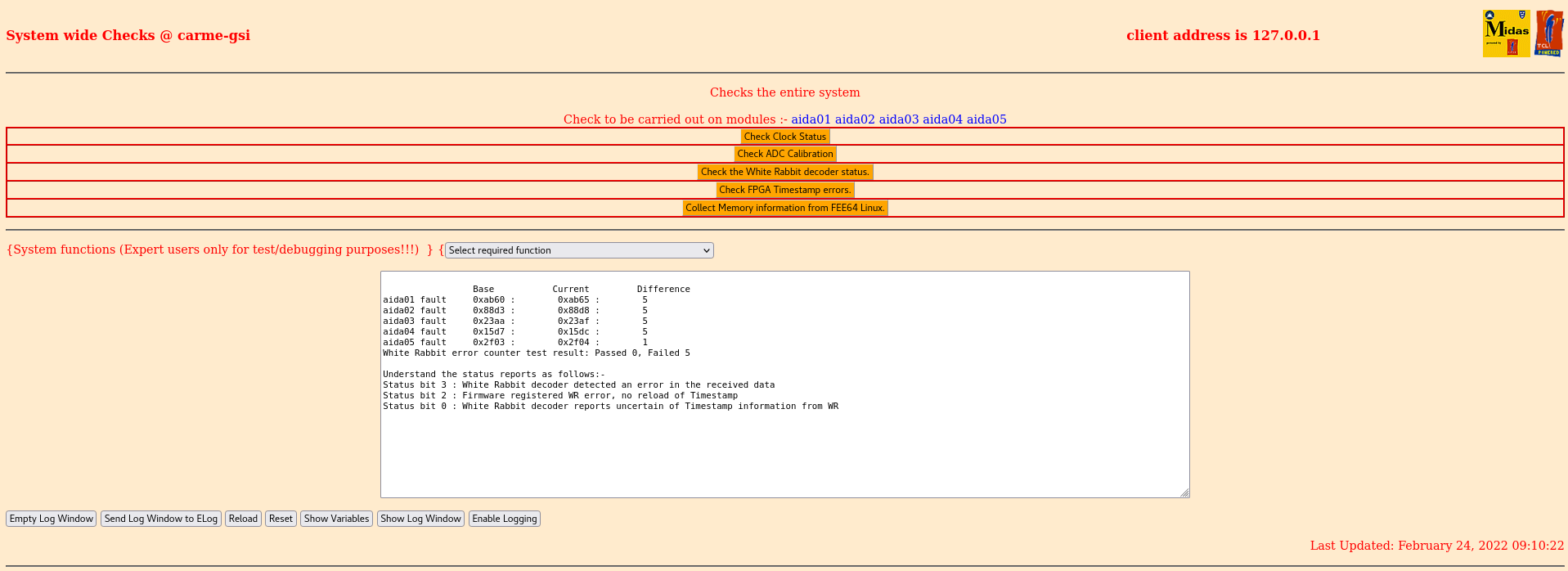
|
| Attachment 8: Screenshot_from_2022-02-24_09-10-08.png
|
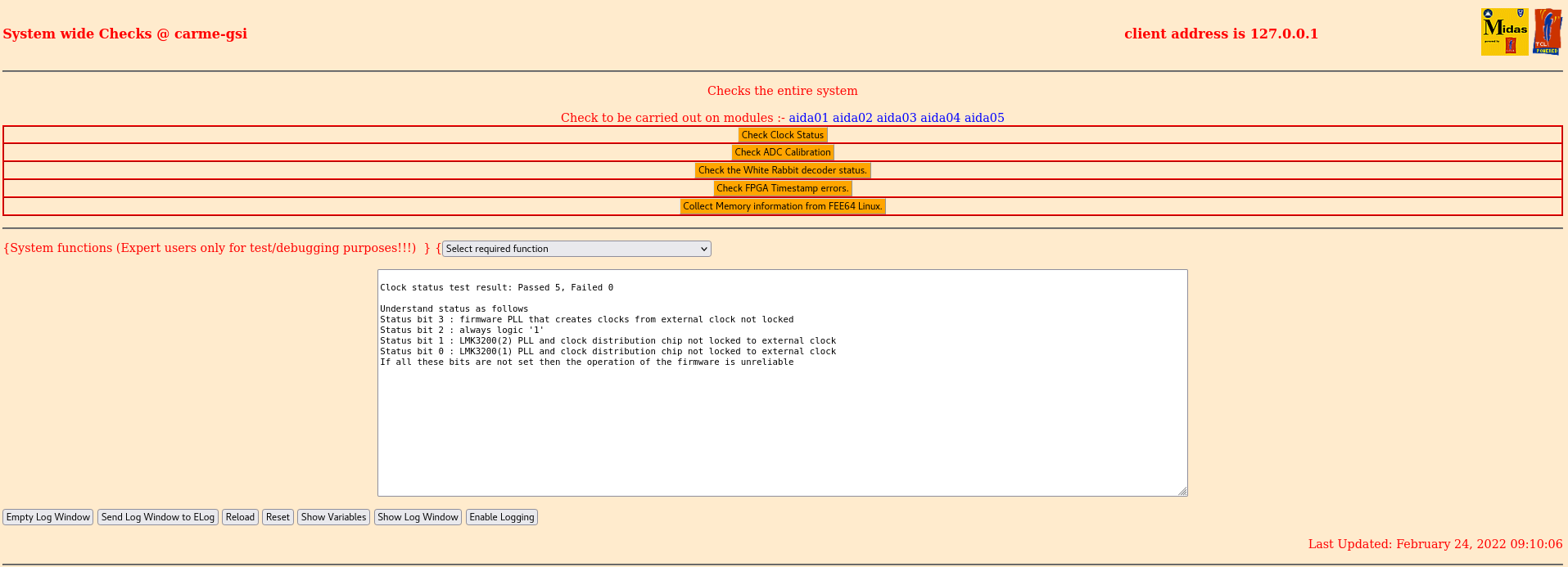
|
| Attachment 9: Screenshot_from_2022-02-24_09-09-36.png
|
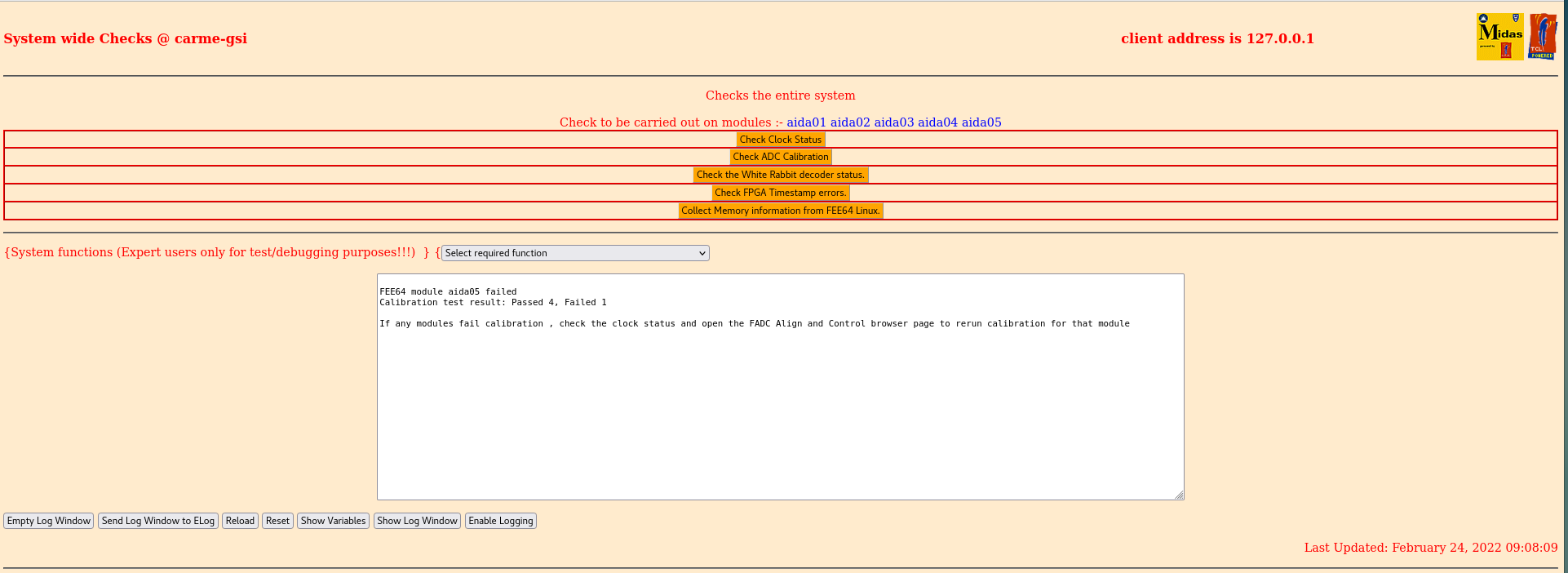
|
| Attachment 10: Screenshot_from_2022-02-24_09-26-41.png
|

|
| Attachment 11: Screenshot_from_2022-02-24_09-26-00.png
|

|
| Attachment 12: Screenshot_from_2022-02-24_09-25-11.png
|

|
| Attachment 13: Screenshot_from_2022-02-24_09-24-52.png
|
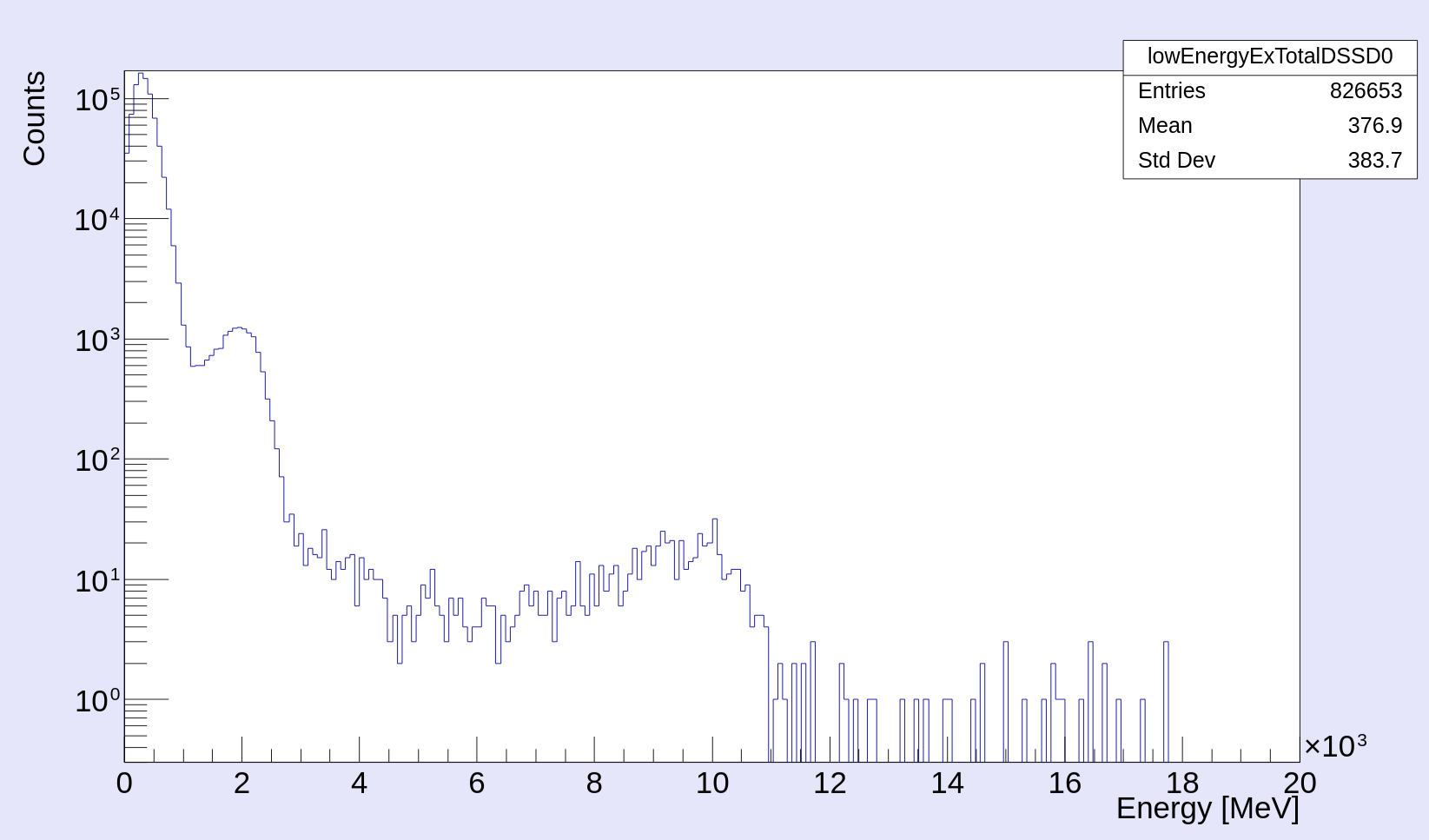
|
|
266
|
Thu Feb 24 07:25:53 2022 |
OH (Remote) | Recover of system after crash |
08:00 Woke up to message from Carlo explaining the server had crashed.
Anydesked into the machine.
Merger was showing just data transfer it was not showing Transfer => Merger
Went through the steps detailed in https://elog.ph.ed.ac.uk/DESPEC/36 to recover it.
After following these steps was again able to forward data from the merger.
Tested and it now sends on data again.
Setup the screen session for the caen bias and restarted the logger program.
Restarted the gnuplot script to plot leakage current
Started the online monitoring software and browser.
Have posted in the chat that the DAQ is now running again. |
|
265
|
Thu Feb 24 05:09:47 2022 |
CB, PE, EM | Inlet valve at target closed + problems with turbopump |
The turbo pump E1 is continuing to draw too much current and the rotation frequency has steadily decreased from 817 Hz at the beginning of the night shift to 800 Hz now. The frequency recovered after the temperature was increased.
Both of the valves (inlet and dump) have been closed to improve the vacuum in the ring. |
|
264
|
Thu Feb 24 04:17:35 2022 |
CB, TD (remotely) | MIDAS DAQ no longer working |
DAQ server crashed around 24:00
Rebooted server but could not could not rescue remotely - could not contact raspberry pi in control of FEE bias.
Entered cave, rebooted raspberry pi. Would not accept remote connections.
Had to manually start DHCP service on carme-gsi using
systemctl start dhcpd
Raspi could then be connected.
Started DAQ, TapeServer and Merger as per usual. Tapeserver refuses writing to disk.
Checked merged - very odd timestamp situation. See attached. Timestamp look OK in the GSI WR tab. See attached.
Power cycled server and FEES
Timestamp issue solved. All are now reading 0x16 etc.
However tapeserver still does not write to disk. Reasons unclear. Possibly Merger is not merging and not passing data on?
Have to stop data collection until solved.
|
| Attachment 1: Bad_Time_2022-02-24_04-34-12.png
|
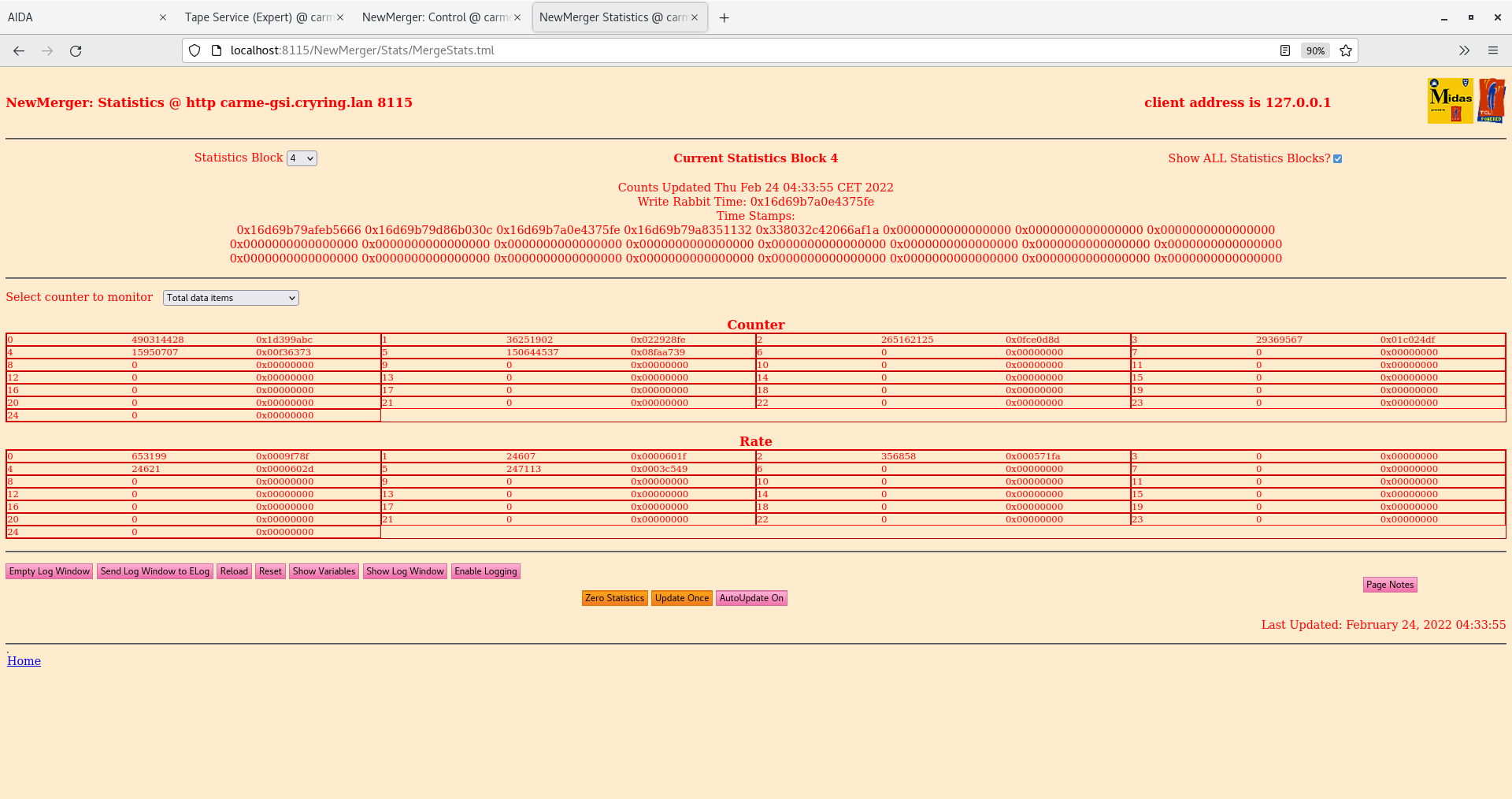
|
| Attachment 2: BadTime_WRTime_2022-02-24_04-34-53.png
|

|
|
263
|
Wed Feb 23 22:29:50 2022 |
PE, EM, CB (remotely) | check - 23:30 |
Motor position ok
Data rate: 1030kbytes/s
T ok
System wide check ok
plots uploaded
DAQ crashed soon afterwards |
|
262
|
Wed Feb 23 21:27:29 2022 |
TD, CN | check |
Motor position ok
Data rate: 1030kbytes/s
T ok
System wide check ok
plots uploaded
|
| Attachment 1: Screenshot_from_2022-02-23_22-29-36.png
|

|
| Attachment 2: Screenshot_from_2022-02-23_22-30-24.png
|

|
| Attachment 3: Screenshot_from_2022-02-23_22-33-23.png
|

|
| Attachment 4: Screenshot_from_2022-02-23_22-36-57.png
|

|
| Attachment 5: Screenshot_from_2022-02-23_22-37-22.png
|

|
| Attachment 6: Screenshot_from_2022-02-23_22-39-50.png
|

|
| Attachment 7: Screenshot_from_2022-02-23_22-41-08.png
|
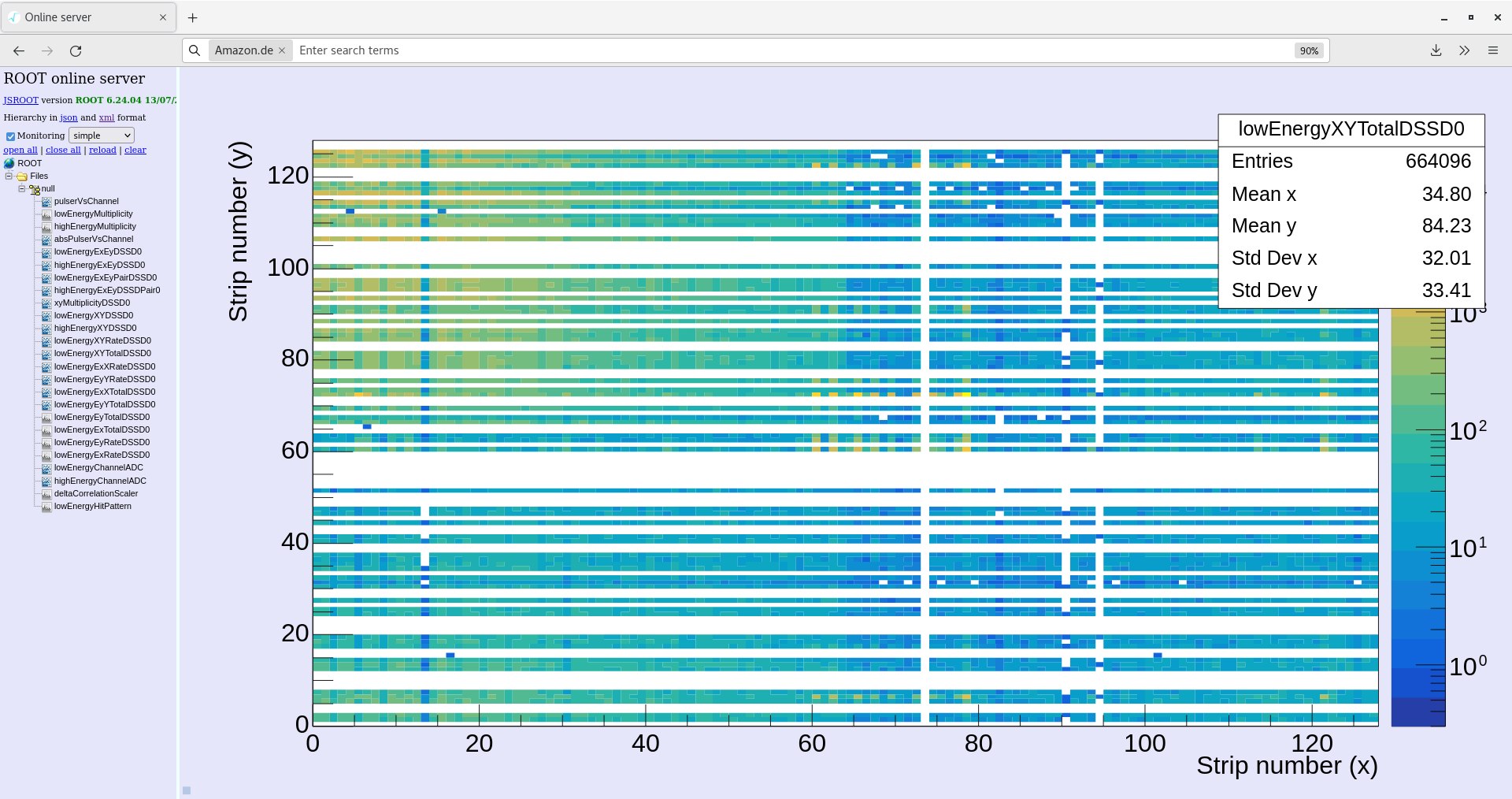
|
| Attachment 8: Screenshot_from_2022-02-23_22-42-51.png
|
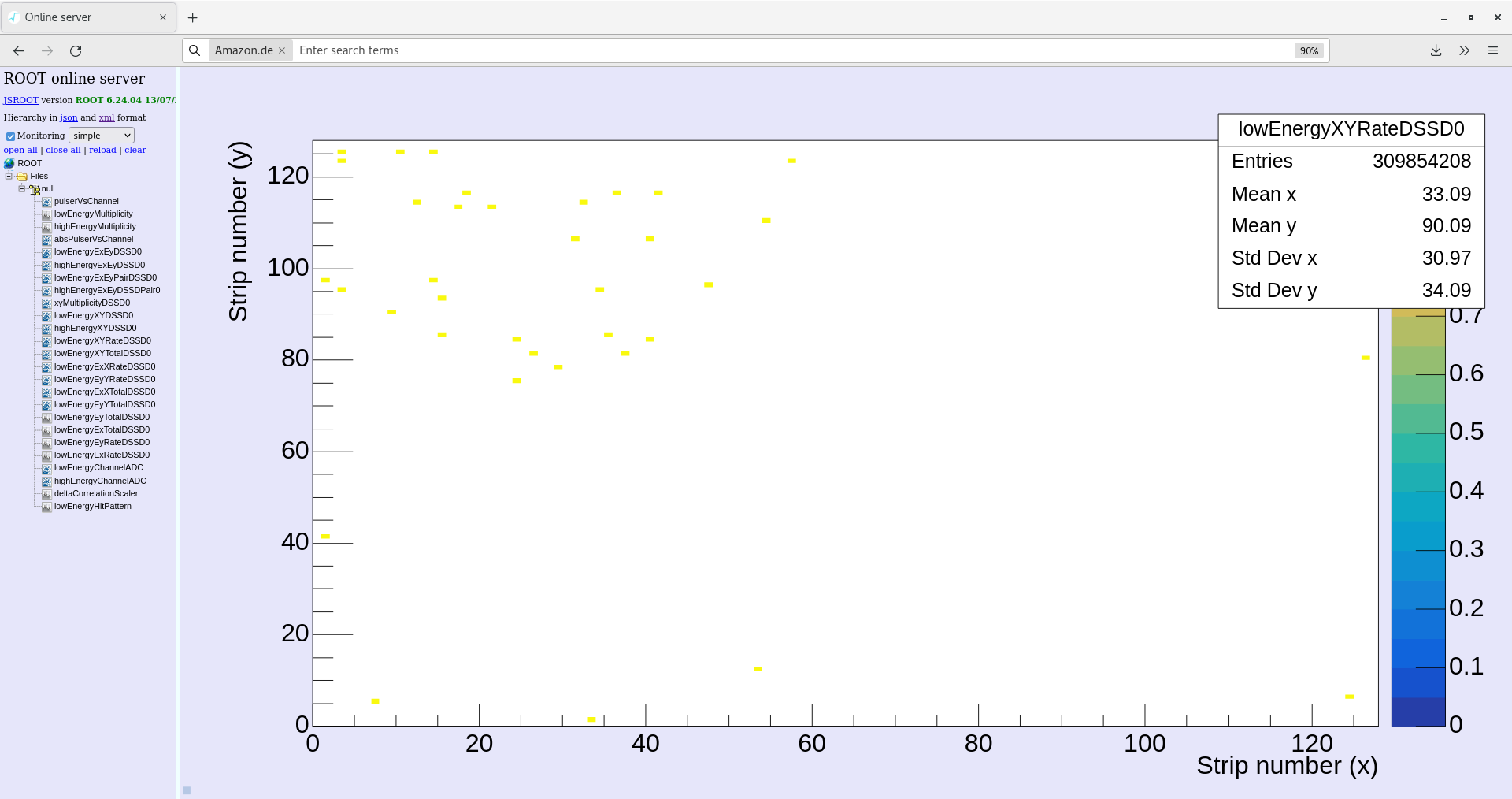
|
| Attachment 9: Screenshot_from_2022-02-23_22-43-16.png
|

|
| Attachment 10: Screenshot_from_2022-02-23_22-43-39.png
|

|
| Attachment 11: Screenshot_from_2022-02-23_22-46-52.png
|

|